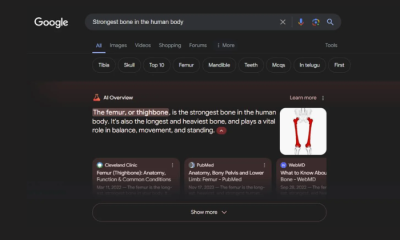Automobile
The Top 20 JDM Cars Of All Time
What JDM compilation would be comprehensive without acknowledging the vehicles that have captivated our, and consequently your, attention over the years? Our selection of the top 20 JDM cars of all time (technically 24; as some stories feature multiple vehicles) encompasses the most sought-after builds we’ve showcased from Japan throughout the years, spanning from Civics and Skylines to S-chassis, RX-7s, AE86s, and more. While we acknowledge that there are countless modified rides deserving of recognition, we’ve confined this list to what we’ve featured in our collective Super Street archives and vehicles originating from Japan, ranked from most frequently visited downwards. Thus, without further delay, we present to you the cream of the crop, our top 20 JDM cars of all time. (Editor’s Note: This list was last updated in January of 2020)
2008 HONDA CIVIC MUGEN RR – Double RR
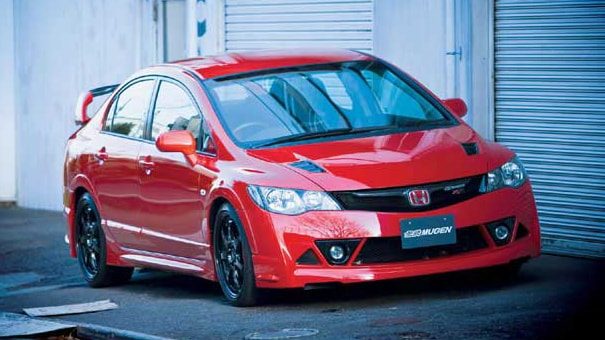
Why We Love It
The FD2 R was the first model with four doors, and the limited edition Mugen RR version—of which only 300 units were made—completely outperformed the USDM Mugen Si. Available exclusively in Milano Red, this enhanced Type R was about 2 seconds faster around Tsukuba Circuit compared to the standard factory model. We still believe that the RR is the Mugen Civic we wish Honda had sold here in the United States.
Mods
MUGEN EVERYTHING—camshafts, valve springs, ram air intake, large capacity intake box, 4-2-1 exhaust manifold, high-flow catalytic converter, straight-type middle silencer, dual exhaust, carbon intake manifold cover; five-way adjustable suspension; slotted rotors (320mm front/282mm rear), brake lines, and carbon air ducts for front brakes; 18-inch Mugen aluminum wheels; Bridgestone Potenza RE070 225/40R18 tires; aluminum hood, carbon front bumper and grille, fog lights, side skirts, fender trim, carbon adjustable rear wing and gurney flap, rear under spoiler with air diffuser, rear fog lights; Mugen-edition carbon Recaro reclining seats, shifter, shift knob, tachometer, meter gauges (water temp, oil temp, oil pressure), sport pedals, and foot rest.
1996 TOYOTA SUPRA RZ (JZA80) – Joke’s On Us
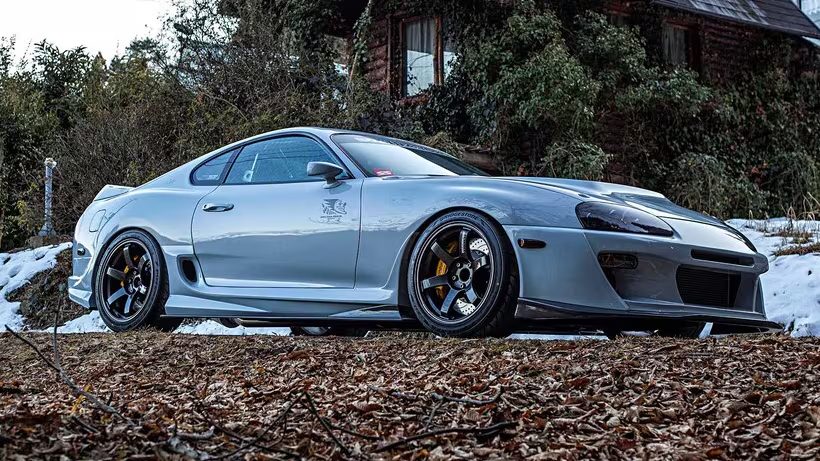
Why We Love It
In a display of its Hurtling Solid & Joker series of affordable aero parts, Varis once again demonstrates its exceptional craftsmanship. The understated HS&J body shaping, combined with Ridox front fenders and BMW Lime Rock grey paint, enhances the appearance of this demo A80 owned by Naohiro Yahagi. This preceded the introduction of an even more aggressive package from Varis—the Supreme Wide Body kit—which significantly widens the fenders. However, we have a preference for Naohiro’s narrow body project.
Mods
The car features an HKS intercooler and intake, an Amuse R1 Titan exhaust, HKS F-Con IS and boost controller, and Blitz coilovers. It also includes Ikeya Formula front and rear upper and lower arms, Original Runduce front and rear big brake kits, 18×10.5-inch +24 Volk Racing TE37 Saga wheels with 275/35R18 Bridgestone Potenza RE71R tires. The exterior is enhanced with Hurtling Solid & Joker front bumper, side skirts, rear bumper, and rear spoiler, Varis front hood, Ridox front fenders, and DoLuck side mirrors, all finished in custom Lime Rock grey paint. Inside, it boasts Recaro SPG GK seats, a Nardi steering wheel, Laile shift knob, Saito rollcage, and an Eclipse head unit.
1996 NISSAN 180SX TYPE X (S13) – Happy Wife, Happy Life
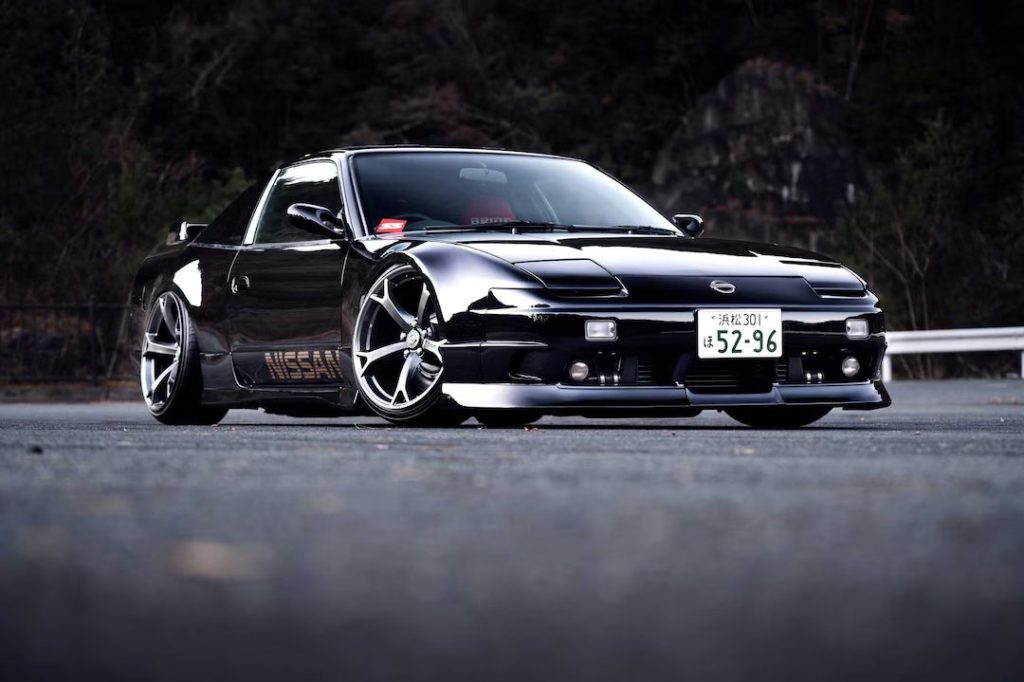
Why We Love It
This S13 was originally intended to be a drift missile, but its owner, Hitomi Ishikawa, persuaded her husband Masaru—an autobody repair technician and genuine car enthusiast—to transform it into a drift-capable showpiece. The addition of 19-inch Rays NISMO rims from a Z34, which is 17 years newer, adds a stylish touch as well.
Mods
The setup includes an HKS GTSS turbo, an intercooler, and a custom exhaust system along with a Silk Road exhaust manifold and a Trust head gasket. The engine bay has been tubbed and shaved. It features a NISMO limited-slip differential and clutch flywheel, as well as an A’PEXi Power FC. The suspension is equipped with HKS shocks and Swift springs, complemented by NISMO arms. Braking is handled by Alcon front big brakes. The car rides on 19×9.5-inch front and 19×10.5-inch rear NISMO Z34 wheels, fitted with 215/35R19 front and 255/30R19 rear Nitto tires. Custom metal fenders have been widened by a total of 250 mm in the front and 400 mm in the rear. The interior features Bride seats, a MOMO steering wheel, a six-point roll cage, an FET shift knob, and an S15 dashboard.
EF HONDA CIVICS – Unpopular Opinion
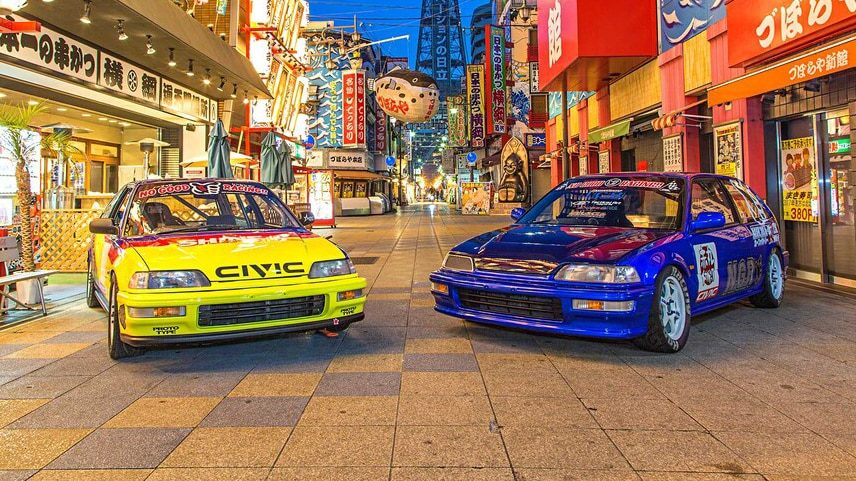
Why We Love Them
These EFs represent the essence of grassroots JDM culture. The tales of Kazuma Tsujimoto and Tsuyoshi Okada from Osaka, members of the No Good Racing crew, and their unwavering dedication to the boxy Civic platform remind us why we became enthusiasts in the first place. Their stories highlight the passion and ambition behind the tuner lifestyle.
Mods
1990 Honda Civic:
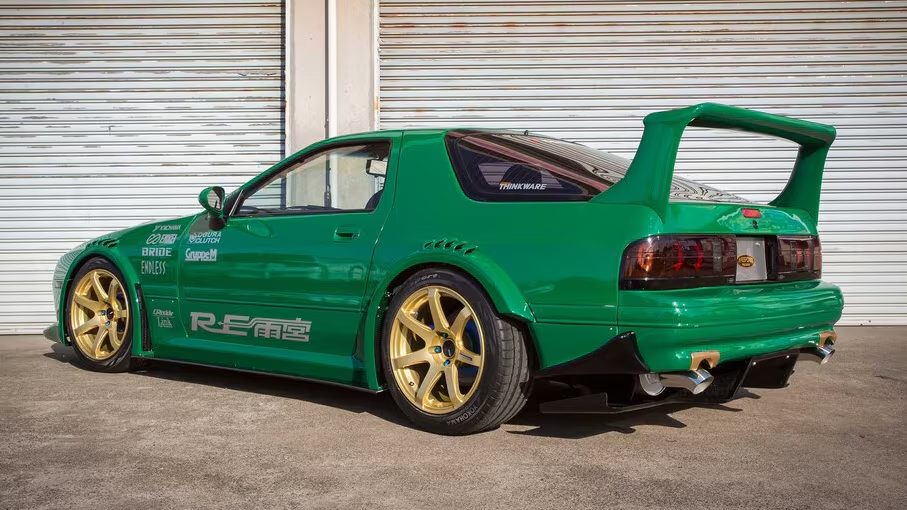
- Engine: B18C with Jun camshafts, valvesprings, retainers, and adjustable cam sprockets.
- Fuel System: Skunk2 composite fuel rail, SARD 380cc injectors, and a fuel pressure regulator.
- Custom Mods: Custom intake pipe, head porting, and exhaust system.
- Electrical and Cooling: Spoon high-tension cord, radiator hoses, and Rywire Mil-spec wiring harness.
- Exhaust: Mugen exhaust manifold.
- Clutch and Transmission: Exedy Hyper Single VF clutch, ATS close ratio gear set for 3rd, 4th, and 5th gears, and a 1.5-way clutch-type limited-slip differential.
- Electronics: A’PEXi Power FC.
- Suspension: Mechadock coilovers and a Cusco tower bar.
- Chassis Mods: Seam welding and spot rivets.
- Wheels and Tires: 15×7.5-in. +35 front, 15×7-in. +35 rear Volk Racing TE37 wheels with 225/50R15 front and 195/55R15 rear Yokohama ADVAN A050 tires.
- Exterior: Custom blue paint, Exceed carbon-fiber hood, and custom headlight duct, fenders, and rear bumper.
- Fuel System: Fuel Safe fuel cell.
- Interior: Custom roll cage, fuse and relay box, switch panel, swirl pot, Shorai battery, Defi gauges, and Bride seats.
- Additional Features: HKS Circuit Attack Counter lap timer.
1991 Honda Civic:

- Engine: B16A.
- Exhaust: Eikoh exhaust and 5Zigen header.
- Oil System: Cusco oil catch can.
- Clutch and Differential: Exedy clutch and a 1.5-way clutch-type limited-slip differential.
- ECU: Spoon Sports ECU.
- Suspension: Mechadock coilovers and Skunk2 front upper arms.
- Brakes: EF9 rotors and calipers.
- Wheels and Tires: 15×7-in. Desmond Regamaster wheels with 205/50R15 Toyo R1R tires.
- Exterior: Custom Clubman Race theme paint.
- Interior: Chargespeed bucket seat and a roll cage.
- Steering: No Good Racing steering wheel and ASR hub.
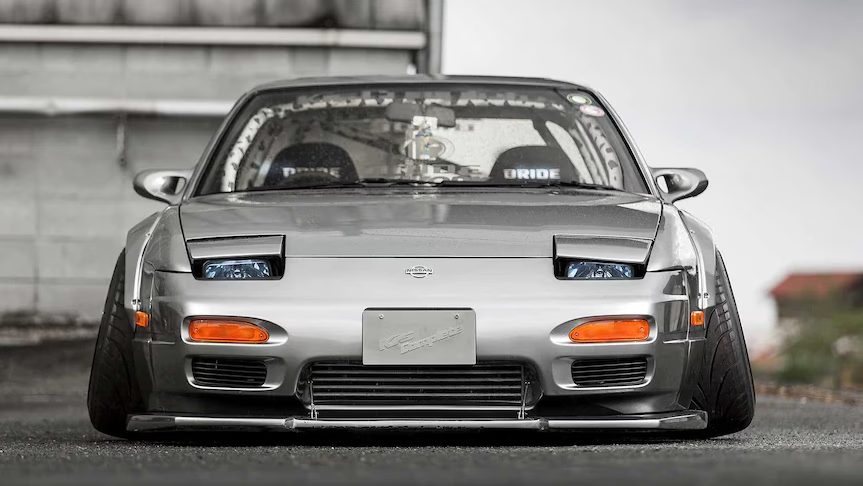
Why We Love It
We’re fortunate to feature one of the renowned pioneers’ creations on this roster, exemplified by Isami Amemiya’s (known for RE Amemiya) FC3S showcased at the 2017 Tokyo Auto Salon. Its contemporary update involves integrating a Cosmo 20B tri-rotor engine swap, delivering an impressive wow factor. These modifications aren’t aimed at mass appeal, but then again, a vehicle of this caliber isn’t designed for the mainstream—and doesn’t aspire to be.
Mods
Conversion of the Mazda Cosmo 20B tri-rotor engine; installation of an RE Amemiya 45mm exhaust manifold and a custom 70mm-to-60mm exhaust system; integration of a Mazda RX-8 six-speed transmission; utilization of an Ogura Clutch metal single plate clutch; incorporation of an OS Giken/RE Amemiya SPL Super Lock limited-slip differential; implementation of the RE Amemiya Extreme Link ECU with a personalized tune; installation of custom RE Amemiya-spec Endless coilovers equipped with Swift springs; adoption of Endless brakes featuring six-piston front calipers; fitting of 17×9-in. +20 front and 17×9.5-in. +8 rear Enkei PF07 wheels; pairing with 245/40R17 front and 255/40R17 rear Yokohama ADVAN Sport V105 tires; application of a custom green paint job; inclusion of Bride EXAS III seats; incorporation of a custom RE Amemiya quick-release mechanism; and utilization of AIM Cluster MXL Strada meters.
1993 & 2000 MAZDA RX-7s – Let Your Soul Glow
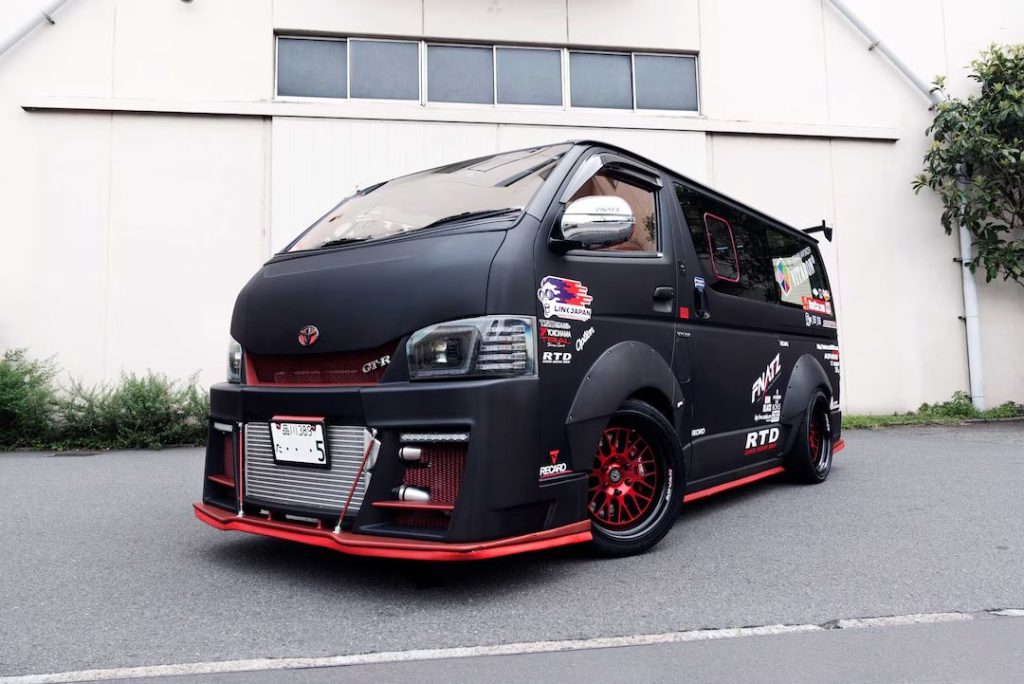
Why We Love Them
A street-oriented approach and a track-focused design characterize the demo FDs from Car Shop Glow, showcasing versatility. While visually similar, the Tokyo builds diverge into distinct pathways.
Mods
’00 Mazda RX-7: Equipped with a TO4S turbocharger and a V-mount intercooler, enhanced by an R33 Skyline fuel pump, Cusco Hyper single clutch, and an RE Amemiya quick shift kit, among other modifications. Sporting A’PEXi Power FC and HKS EVC 6 boost controller for performance management, it rides on Cusco ZERO-3 coilovers and Satoru Works knuckles, complemented by 18×10.5-in. +18 Volk Racing TE37 wheels wrapped in 265/35R18 Dunlop Direzza ZII Star Spec tires. Interior upgrades include Bride seats and a Saito Racing rollcage, while exterior enhancements feature TCP Magic Type GT widebody fenders and RE Amemiya styling components along with Car Shop Glow LED lighting and a Mazioria Trapezium five-stage paint finish.
’93 Mazda RX-7: Enhanced with balanced rotors and Fuji WPC-treated 3-piece Apex seals, along with a V-mount intercooler setup featuring Knight Sports radiator and Zest Racing piping. Boasting a variety of performance upgrades such as HKS Racing Suction, Trust front pipe, and R Magic mid pipe, it’s powered by an A’PEXi Power FC and HKS EVC 6 boost controller. Riding on Car Shop Glow GT Spec coilovers and Swift springs, it rolls on Volk Racing TE37SL wheels and Yokohama Advan tires. Exterior modifications include RE Amemiya AD Facer N-1 ’05 styling elements, Car Show Glow LED lighting, and a Vortex GT wing, all finished in Pearl Brown paint. Interior upgrades comprise Recaro SP-G seats, OMP Superturismo steering wheel, and RE Amemiya accessories for an enhanced driving experience.
1993 NISSAN S13 – Super Hiro

Why We Love It
Hiroki Koga has crafted an exceptional Onevia, going beyond the typical 180SX-nosed S13 Silvia. As the proprietor of a VIP shop, he has created a formidable stance machine boasting close to 600 horsepower, showcasing the superior craftsmanship to potential clients.
Mods
The 2.2L SR20DET black-top engine is enhanced with HKS H-beam connecting rods, pistons, and a 91mm stroked/fully balanced crank. It features a Power Enterprise 1.5mm head gasket, 272° cams, Tomei B Type valvesprings, and NAPREC valves. Fuel delivery is managed by a Hypertune 80mm throttle body, a 265-lph SARD fuel pump, fuel pressure regulator, and 800cc injectors. Boost is provided by a GCG 3076 turbo and wastegate, complemented by an HPI High Spec intercooler. The engine is equipped with a WPC-treated oil pump, HPI air intake, and radiator. Exhaust flow is optimized through an Altrack 45mm exhaust manifold, custom exhaust, turbo outlet, and front pipe.
Power is transmitted via an HPI six-speed dog gearbox, NISMO Super Carbon twin-clutch, flywheel, and 4.1:1 GT limited-slip differential. Boost control is managed by a Blitz Dual SBC boost controller. Suspension upgrades include HKS HiperMax III special version coilovers, a NISMO strut bar, and Ikeya Formula control arms. The chassis is reinforced with spot welding. Braking performance is enhanced with OE Skyline R33 Type M calipers, Dixcel rotors, and Project Mu pads.
The car rides on 17×10.5-in. Work Meister M1R wheels wrapped in 235/40R17 Federal 595RSR tires. Exterior modifications include a KIS front lip spoiler, side skirts, rear bumper canards, rear diffuser, over-fenders, and trunk spoiler. Interior upgrades consist of a Nardi steering wheel, Bride Zeta III seats, and Defi tachometer and gauges.
TOP SECRET’S V12 TWIN TURBO TOYOTA SUPRA
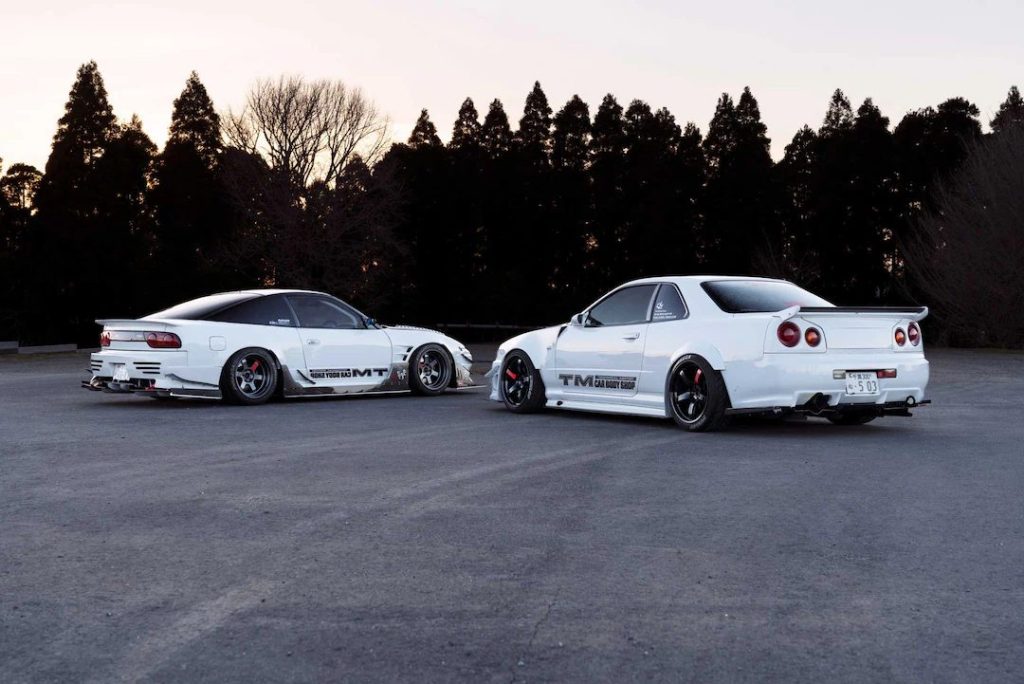
Why We Love It
Nagata’s desire wasn’t for a BMW but for the Supra Smoky—a golden, wide-bodied, 1,000hp beast with a twin-turbo V12 engine, specifically the MkIV model. Toyota, over to you.
Mods
Equipped with a potent 5,000cc 1GZ-FE engine, this vehicle boasts twin HKS GT2540 turbines and dual HKS blow-off valves and wastegates. Enhancements include a custom Top Secret intake plenum with twin 80mm throttle bodies, ARC intercooler, and a rear-mounted radiator. Power is transmitted through a JZA80 Getrag transmission, controlled by a Cusco 1.5 way LSD and ORC clutch. The suspension features Top Secret coilovers with Roberuta Cup kit for precise handling, complemented by Volk Racing GT-F 19-inch wheels wrapped in Bridgestone Potenza RE050A tires. Braking power is provided by GReddy GREX eight-piston front and four-piston rear calipers. The aggressive Top Secret Super G-Force Wangan widebody kit enhances aerodynamics, with additional Top Secret carbon aero components and HID headlights. Inside, the vehicle is appointed with Bride Gias leather seats, Takata harnesses, and a Top Secret steering wheel and shift knob. Advanced instrumentation includes a Defi Super Sports cluster and Carrozzeria Navigation system.
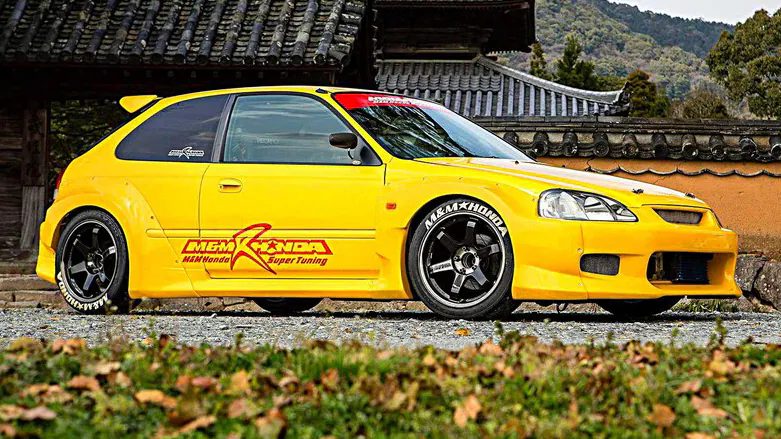
Why We Love It
A minivan with the heart of an R35 GT-R—what’s not to adore? Ju Sung Oh’s turbocharged, boxy vehicle is the ideal choice for those seeking a powerful yet practical family transporter.
Mods
The engine swap features a VR38DETT; TRUST intercooler enhances performance; equipped with a 3.0L diesel manual transmission; OS Giken components including clutch, flywheel, and differential optimize functionality; Link ECU ensures precise control; AiM MXS Strada tachometer offers comprehensive monitoring; Final Konnexion coilovers provide dynamic handling; stopping power is delivered by AP Racing Pro 5000+ six-piston calipers; T-Style X-Three wheels in 19×9-in. +20 size add a stylish touch; Yokohama Advan Neova tires sized 265/35R19 at the front and 275/35R19 at the rear ensure superior grip; KITZ-RACING bumpers, CRS hood, and over-fenders enhance aesthetics and aerodynamics; URAS rear spoiler adds a sporty flair; interior features Recaro seats, a Nardi steering wheel, and red upholstery meticulously reupholstered.
2010 HONDA ACCORD TOURER – Love at First Sight
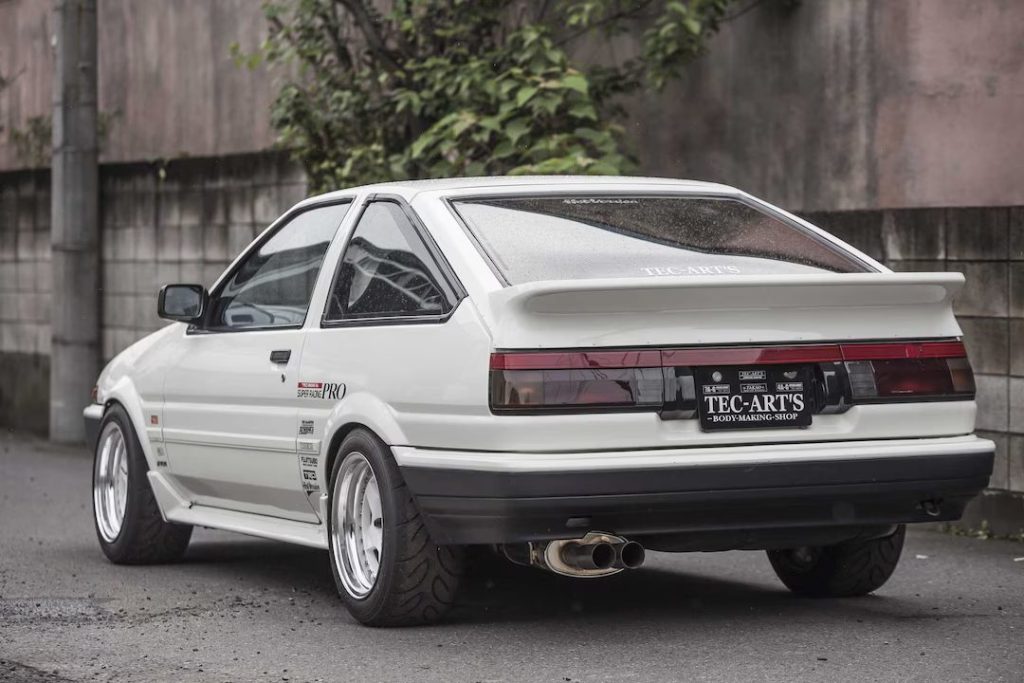
Why We Love It
The level of dedication poured into Norifumi Kobayashi’s Honda wagon goes beyond mere obsession, evident in various remarkable features, including the meticulously styled shaved engine bay influenced by USDM aesthetics, setting a new standard from across the ocean.
Mods
The OEM K20A Type R valve cover, alternator bracket, alternator, air conditioning compressor, and air conditioning compressor bracket are included. Additionally, it features a Skunk2 Pro Series intake manifold, Alpha Series header, and K-Tuned components such as the fuel rail, coil pack cover, tensioner bracket, and mufflers. It utilizes OEM Acura RDX Denso injectors and Mishimoto aluminum radiator, transmission oil cooler, and reserve tank. A custom exhaust system, wire tuck, and shaved engine bay enhance its performance.
The HKS F-Con IS is integrated, along with custom coilovers, sway bars, and front upper control arms. Voodoo13 rear control arm and front lower control arms are also part of the setup. The vehicle boasts 380mm front and 355mm rear StopTech big brake kits, paired with 19×10.5-in.
Arcane Legend wheels with titanium hardware and 235/35R19 Nitto NT555 tires. For aesthetics, it features an OEM Acura TSX wagon front bumper, rear bumper, headlights, front grill, taillights, rear gate, rear gate panel, roof antenna, mirrors, front underbody spoiler, side underbody spoiler, body side molding, door handle frames, all glass, windshield wipers and arms, all coated in OEM Milano Red paint. Black chrome elements like the grille emblem, side window moldings, and door handles add a sleek touch.
Interior features include Status Racing SRA Icon seats, harnesses, suede and leather diamond-stitched seats, door panels, and OEM Acura TSX leather steering wheel, leather shift knob, SRS airbag, hazard switch, steering wheel hands-free switch, sun visor, upper console (Homelink switch), scuff plate, dimmer switch, turn signal stalk, passenger airbag warning light, ELS system, rear pillar garnish, gauge cluster, window switch, A/C switch panel, center console, and side brake handle.
1998 NISSAN SKYLINE 25GT & 1995 180SX – There’s Something About Nissan
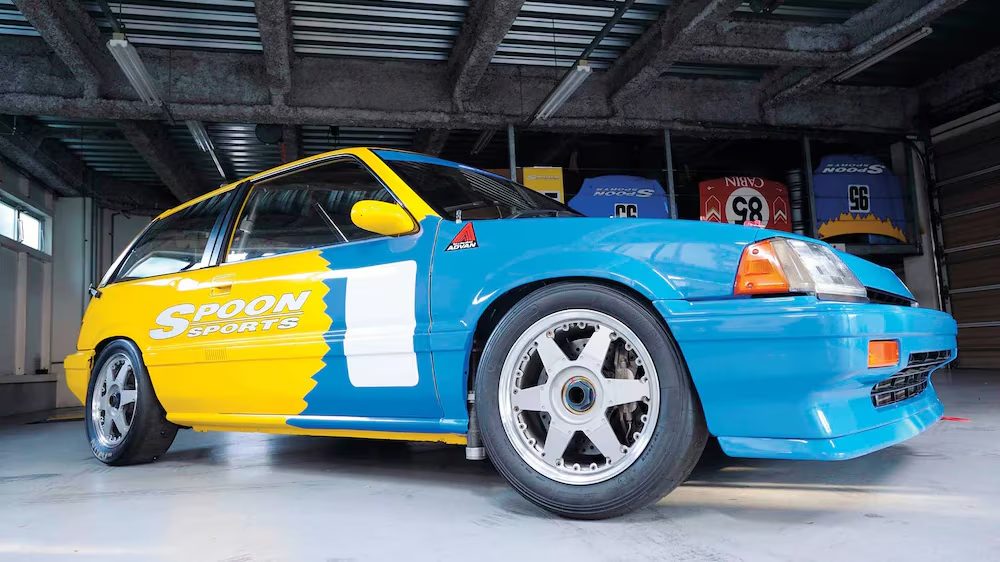
Why We Love Them
We envision a scenario where we possess both a 180SX and a Skyline, customized specifically for drifting with a significant infusion of J-style. Masao Otani, renowned as the painter and bodywork specialist at RE Amemiya, meticulously crafted the RPS13 for maneuvering through short, intricate circuits and the ER34 for delivering substantial power on larger tracks. Despite their distinct purposes, our affection for both vehicles remains equal.
Mods
In the ’98 Nissan Skyline 25GT Turbo (ER34), there’s been a notable RB26DETT swap, along with the installation of a TRUST T78 33D turbine kit. Enhancements include a 272? lift 9.1 cam, a three-layer intercooler, and a surge tank. The vehicle also boasts a NISMO adjustable fuel pressure regulator, a reinforced fuel pump, and SARD 720cc injectors. Performance upgrades extend to a Buddy Club 90mm stainless muffler (with silencer removed), an OS Giken triple-plate clutch, and a KAAZ two-way differential with a 4.9 final gear. Additional modifications include an HKS Fcon Vpro, EVC 5, and A/F knock amplifier, as well as a BNR34 GT-R V-Spec speedometer and tachometer. The car rides on A’PEXi N1 Damper Pro coilovers, Swift 14K front and 12K rear springs, and features custom pillow ball tension rods, front and rear adjustable upper arms, and HICAS cancel rods. Braking performance is enhanced by slotted and dimpled front rotors, BNR32 drilled rear rotors, and Project Mu HC pads and side shoes. The aesthetic upgrades are extensive, including various body kit components, custom paint, and a range of interior enhancements like Recaro SP-G seats and a Takata four-point harness.
Meanwhile, the ’95 Nissan 180SX (RPS13) features an SR20DET engine, coupled with a range of performance upgrades. These include a stainless exhaust manifold, turbo outlet pipe, front pipe, and cat replacement, alongside an 80mm titanium muffler with a dolphin tail tip. The vehicle is equipped with an aluminum pulley kit, ORC metal single clutch, and KAAZ two-way differential with a 4.6 final gear. Transmission enhancements extend to a reinforced mission mount, short shifter, and rigid differential and subframe mounts. Other performance modifications include a TRUST Profec boost controller, Defi Link Meter, and CST coilovers. The car rides on Volk Racing TE37V wheels painted a custom color, paired with 255/40R17 Dunlop Direzza ZII Star Spec tires and 2mm front spacers. Aesthetic enhancements include a carbon-fiber hood with Garage Mak vents, Origin Labo front and rear over-fenders, custom side steps, and a rear bumper. The interior features Bride bucket seats, Sabelt four-point harnesses, a MOMO steering wheel, NISMO shift knob, and an eight-point rollcage.
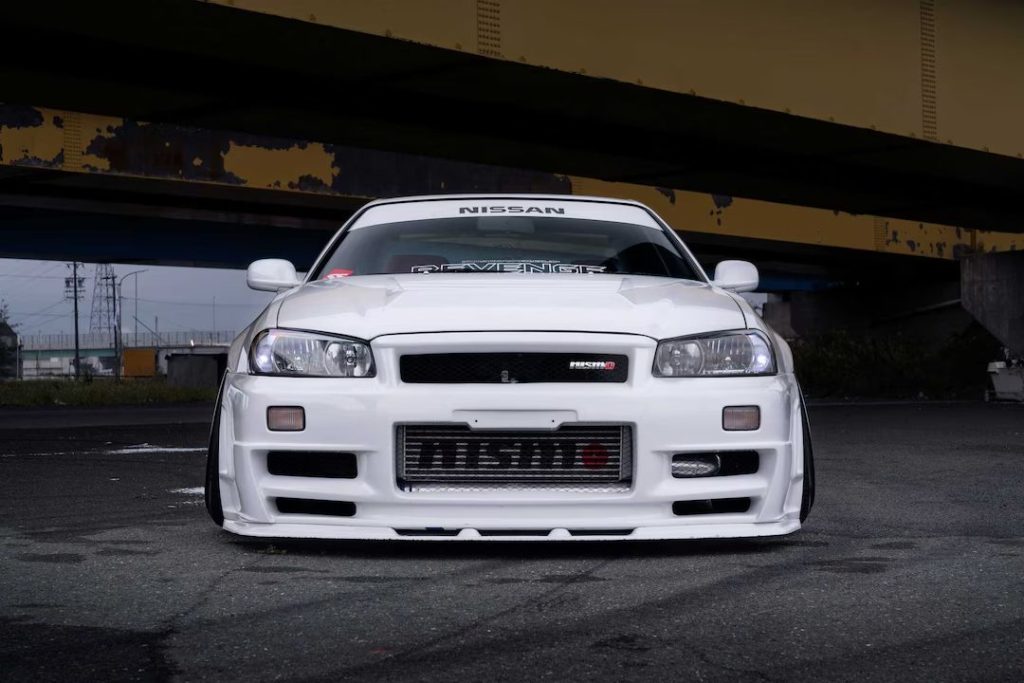
Why We Love It
The EK9 stands out as perhaps the ultimate representation of high-performance sport compacts from Honda in the 1990s, and Kazuyuki Hashinaga’s modified hatchback, enhanced by M&M Honda, pushes the limits of its chassis to serve as a versatile daily driver capable of excelling on the track as well. The narrative of this project began 11 years ago, and it continues to evolve.
Mods
The B16B engine features a compression ratio of 12.4:1 and includes various upgrades such as a TODA Racing 0.6mm head gasket, camshafts, valve springs, forged connecting rods, and 81.5mm forged pistons. Other enhancements comprise an upgraded oil pump, M&M Honda cross mission, intake chamber, 50mm exhaust manifold, and a 60mm titanium exhaust system. Cooling is optimized with a modified Koyorad aluminum radiator. Transmission improvements include a TODA Racing metal single clutch and flywheel, along with a 4.7:1 final drive and an ATS 1.5-way limited-slip differential. The engine management system is controlled by an A’PEXi Power FC. Suspension upgrades consist of M&M Honda-spec Ohlins coilovers featuring 20kg front and 16kg rear springs, complemented by M&M Honda strut bar, roll center adjuster, and tie rods. The chassis is reinforced with spot-welded frames. Rolling on 16×8.5-in. -5 Work Seeker GX Candy Red wheels wrapped in 225/40R16 Yokohama Advan Neova tires, the vehicle also sports a M&M Honda Hyper Wide body kit including front bumper, side skirts, rear diffuser, and hood, as well as a flat bottom diffuser. Interior modifications feature Bride seats, Takata harnesses, and a MOMO NSX-R steering wheel, along with Defi meters for monitoring performance metrics.
1986 TOYOTA SPRINTER TRUENO – Original Gangsta’

Why We Love It
Is it even necessary to inquire? This is none other than Keiichi “Drift King” Tsuchiya’s AE86, his personal ride.
Mods
TEC-ART’S has enhanced the performance of the 1.8L “7AG” engine, which comprises an AE111 head paired with a 7AFE block. Upgrades include camshafts, timing belt, pistons, rods, pulleys, engine mount brackets, a large capacity curl funnel, exhaust manifold, direct ignition kit, and radiator. Additionally, TODA Racing valve springs and head gasket, a Sard fuel pump, and a K1 Planning exhaust have been incorporated. The setup is further bolstered by a Setrab 34-row oil cooler, a TRUST oil element relocation kit, and TEC-ART’S N2 Cross Mission gears. A custom 7AG carbon clutch and solid shift lever optimize transmission performance. Electronic control is managed by a MoTeC M84 ECU. Suspension enhancements feature TEC-ART’S x Aragosta coilovers, polyurethane bushings, lower control arms, and a stabilizer bar, all contributing to a stitch welded chassis for added rigidity.
Braking power is ensured by Soarer20 calipers, Endless brake pads, and TEC-ART’S stainless mesh brake lines. The vehicle is fitted with 15X8.5-inch +3 Work Meister CR01 wheels wrapped in 195/50R15 Goodyear RS sport tires. Aesthetically, it boasts an Impulse carbon-fiber roof, a custom dry carbon hood, and a Carbon Gate trunk. Aerodynamic elements include a TRD wing. Interior enhancements encompass Bride King seats with rails, Schroth harnesses, and a TRD steering wheel and shift knob, along with a TEC-ART’S leather dash panel.
SPOON SPORTS HONDA E-AT CIVIC – You Thought You Knew
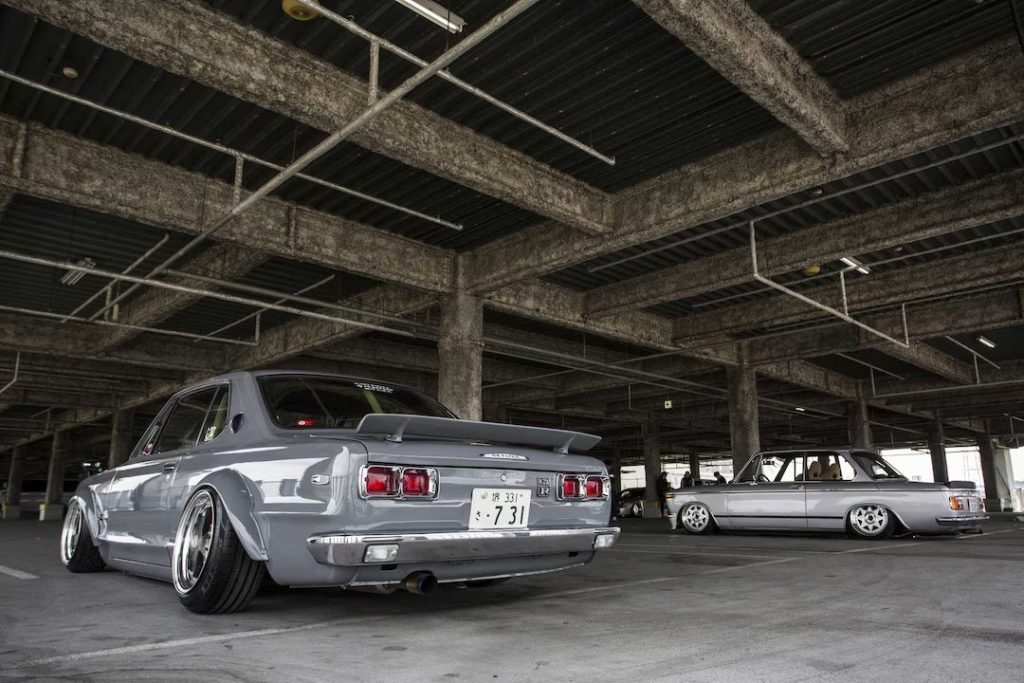
Why We Love It
The Group A E-AT hatchback, now retired, holds a special place in Honda’s legacy, embodying the early racing ideals and philosophy of the renowned tuner, Spoon Sports. Interestingly, many mistakenly identify it as an EF model.
Mods
Naturally-aspirated ZC Engine with a displacement of 1.6 liters and a double overhead camshaft configuration; Features include a Spoon valve cover, aluminum oil pan, oil cap, reservoir covers, and a straight pipe-exhaust of the megaphone type, along with a custom header equipped with spring flange joints; NGK spark plug wires are utilized, with a grey sealer paint applied; Equipped with a Keihin ECU and a 5-speed close ratio transmission; Suspension system features Showa struts; Safety enhancements include a custom aluminum rollcage, front torsion bars, rear springs, a front strut tower bar, and front/rear swaybars with spherical endlinks, as well as an adjustable panhard rod and air jacks, and a single lug conversion; Braking system comprises Nissin calipers, an adjustable proportioning valve, and 2-piece drilled rotors; Rolling on 15X8-inch (front) and 15X6.5-inch (rear) center-locking Enkei wheels fitted with 205/55 R15 Vintage Yokohama Advan SS tires; A flat panel is positioned underneath the car for aerodynamic purposes; Sporting a Spoon Sports paint scheme, decals, and windshield banner, alongside tow hooks, EC Works Type A mirrors, and hood pins; Equipped with a fender-mounted air jack wand; Interior features include custom gauges, a Spoon Sports first-generation steering wheel, a carbon-kevlar bucket seat, Simpson harness, and custom seat brackets, all complemented by a battery kill switch.
NISSAN SKYLINE GTT (GF-ER34) – Young & Determined

Why We Love It
What do you do when you’re young, short on cash, passionate about drifting, and also a fan of Godzilla? You save every penny and get yourself a rear-wheel-drive Skyline GTT to customize for those impressive drifts. That’s exactly what young enthusiast Kenshi Otake did with his unique ER34.
Mods
RB25DET NEO engine; Ho-Wa dual exhaust system; NISMO clutch, GT LSD Pro; SR Sports Racing dampers; 326 Power springs; IKEYA Formula front upper arms and tension rods; YURA-MODE 30mm lower arm extensions; 18×9.5-inch +15 Stance Magic #130 wheels; 225/35R18 Sunew tires; 20mm spacers; NISMO Z-Tune style front fenders and front bumper; Okubo Factory front diffuser and rear over-fenders; Z.S.S. carbon-fiber hood; BNR34 rear bumper and tail lamp covers; BNR34 style side skirts; URAS roof spoiler; D-Max S15 style trunk spoiler; East Bear rear under spoiler; OE Nissan Cloud White QM1 paint; bucket seat; MOMO steering wheel; Razo shift knob; Blitz turbo timer.
1986 TOYOTA COROLLA (AE86) – Prime Time

Why We Love It
Eiji Daito created E. PRIME to focus on the Hachi-roku, and this Corolla might be the best one ever produced by the shop. While the ’90s are currently popular, this ’80s icon demonstrates their origins.
Mods
1.6L 4AG engine with AE92 4AGZ oil pump, pistons, crankshaft, and coil system; AE101 20v rods; ported cylinder head; Toda camshafts and valvesprings; 1.5mm head gasket; NGK #10 spark plugs; dual Bosch fuel pumps; ATL fuel tank; Mitsubishi Lancer Evo 550cc injectors; SARD fuel pressure regulator; TD05-20G turbo; HKS wastegate; HPI air filter; custom Total Create E. PRIME 80mm exhaust piping and 45mm exhaust manifold; modified Mazda FD3S intercooler; Setrab oil cooler; Koyo radiator; Nissan Skyline 71C transmission with custom bellhousing; OS Giken Super Single clutch and flywheel; 3.9:1 final gear ratio; Cusco two-way limited-slip differential; Freedom ECU; Ennepetal front suspension; TRD rear shocks; TEIN springs; TRD stabilizer bars; custom Total Create E. PRIME strut bar and 14-point rollcage; spot-welded chassis; Mazda FD3S front calipers; Endless brake rotors and pads; 15×9.5-in. Work Equip 40 wheels; 225/50R15 ADVAN A050 tires; NA Works front bumper; custom Total Create E. PRIME front fenders and rear over-fenders; Mercury side skirts; Subaru Violet Blue paint; OMP steering wheel; Bride Zeta III bucket seat; Sabelt harnesses; Defi meters; Ultra tachometer.
1970 NISSAN SKYLINE 2000 GT-X & 1975 BMW 2002 – Making Moves
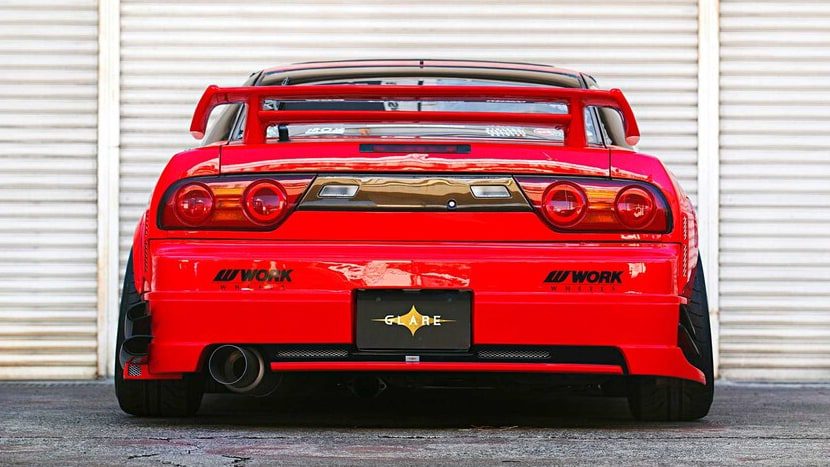
Why We Love Them
We were unaware that the C10 Skyline coupe and the 2002 were like twins separated at birth. This unexpected duo of lowered classics from AP Garage captivated everyone at the 2018 Osaka Auto Messe, and it’s easy to understand why they drew so much attention.
Mods
’70 Nissan Skyline 2000GT-X (KGC10)
- Engine: Swapped to a 2.8-liter, 12-valve L28 straight-six with Mikuni carburetors and a titanium exhaust. Cusco catch can installed.
- Drivetrain: Equipped with a five-speed manual transmission.
- Suspension: Pneumatec air suspension with air management integrated into the center console.
- Wheels and Tires: 16×9-inch front and 16×10-inch rear Super Star Chevlon Racing S1C wheels with titanium hardware, fitted with 195/45R16 front and 225/45R16 rear Toyo Proxes tires.
- Body and Exterior: Custom bumpers, hood, fender mirrors, rear wing, Fenderworks riveted-on over-fenders, and custom grey paint.
- Interior: Custom green leather upholstery, Recaro seats, Nardi steering wheel, push-button start, titanium shift knob, and a custom roll bar.
’75 BMW 2002
- Footwork & Chassis: Pneumatec air suspension with air management integrated into the center console.
- Wheels and Tires: 16×6.5-inch +21 front and 16×7-inch +17 rear i.force FD-80H forged wheels with 165/45R16 Toyo DRB tires.
- Body and Restoration: Restoration and paintwork done by S& Company.
- Interior: Bride seats, Renown steering wheel, custom tan leather and suede upholstery, Carrozzeria head unit and speakers, and an Optima Red Top battery.
1996 HONDA CIVIC FERIO VTI – New Era

Why We Love It
Tomoyuki Sasaki’s Civic, crafted by the Osaka-based tuning shop Tactical Art, was arguably the most extensively modified Civic in Japan at its peak. Designed with a USDM-inspired aesthetic, it blends Western imagery with traditional Japanese craftsmanship, bridging two distinct philosophies.
Mods
’96 1.8L Honda B18C (Integra Type R) with Hasport engine mounts; Mugen JASMA 4-1 exhaust manifold; Skunk2 Pro Series intake manifold, adjustable cam gears, composite fuel rail, and 80mm throttle body; Alpha Series half-size radiator, cooling hoses, oil cap, and radiator cap; Blox Racing fuel pressure regulator; -AN fuel fittings and fuel lines; Tactical Art custom intake pipe and 60mm stainless straight-pipe exhaust; Downstar Inc. engine bolts and accessory hardware; S80 five-speed manual transmission; K-Tuned B-series shifter; Hondata S300; Rywire Mil-spec engine harness; Tactical Art coilovers with 20kg front and 18kg rear spring rates; custom rollcage and rear speaker decklid delete; Function7 rear subframe brace and Ultra-Light control arms; Rywire brake line kit and custom steel lines; 16×8.5-in. CCW D110 wheels with 225/45R16 Advan Neova AD08 tires; OEM ’99-’00 Ferio Vi-RS grille, front bumper, rear bumper, and trunk; USDM ’99-’00 headlights and taillights; custom carbon-fiber canards; Tactical Art/Exceed JP front lip; engine bay repainted in Tactical Art Gray; Mechadock/Exceed JP carbon-fiber hood; Lamborghini Arancio Ishtar paint; Bride Zeta III Sport seats; Takata Race safety harnesses; MOMO steering wheel; NRG steering hub and quick release.
1994 NISSAN 180SX (S13) – Bringin’ Seki Back
Why We Love It
Yuichi Seki cherished his stunning S13 for 18 years by the time it was showcased in 2017. Initially a former drift car, it now eagerly participates in time attack events at the nearby circuit and garners accolades at various car shows.
Mods
Equipped with a Tomei 2.2L stroker kit, Rising connecting rods, and a NAPREC High Response kit, this vehicle boasts a Trust TD06-25G turbo kit, along with an oil cooler, surge tank, and star head bolt. Enhancements include a Blitz intercooler, Copper three-layer radiator, and an Infinity 90mm throttle body. Its performance is further augmented by a NISMO metal head gasket, reinforced valve springs, and a HKS six-speed H-pattern dogbox transmission. The drivetrain features a NISMO Super Copper Mix clutch and flywheel, a 4.1 final gear, and a Tomei two-way limited-slip differential. Control is optimized through an A’PEXi Power FC, Blitz SBC boost controller, and HKS turbo timer. Suspension upgrades include HKS Hipermax D’NOB Spec coilovers, Ikeya Formula tie rods, and KTS tie rod ends. Other enhancements comprise of Kazama Auto tension rods, Garage Mak knuckles, and Cusco toe control arms. Braking performance is improved with R33 GT-R four-piston front calipers, complemented by Work Meister S1R wheels wrapped in Toyo Proxes R1R tires. Exterior modifications feature Garage Mak Revolution bumpers and 55mm front and rear fenders, as well as Seki Motorsports under panel and side fins. The interior is equipped with a MOMO steering wheel, Works Bell Rapfix II quick release, Bride seats and floor mats, and Schroth 3-inch belts. Safety is enhanced with a Cusco nine-point roll bar and rear triangle bar pillar bar. Carbon-fiber dashboard and Defi 52mm gauges add a touch of sophistication, complemented by a Pivot shift lamp.
1991 NISSAN 180SX – One-Man Wonder
Why We Love It
Takashi Haruyama, the renowned ex-professional drifter and head of Car Modify Wonder, refers to this S13 as the epitome of “Saitama street style.” However, we simply see this unique fastback as incredibly impressive and cool.
Mods
Equipped with an SR20DET engine, this vehicle boasts several performance enhancements including an HKS exhaust manifold and exhaust system, along with a boost controller for improved power delivery. A custom downpipe complements the Trust turbocharger, while the Blitz type 2 intercooler and intercooler pipes ensure efficient cooling. The drivetrain features an OS Giken twin-disc clutch and a NISMO two-way limited-slip differential for enhanced traction. Tuning is managed by an HKS F-Con system, while handling is upgraded with Revolver-R Track-R coilovers. Stopping power is provided by Project Mu D1 spec pads and rotors. The car rides on 18×10-inch Work Emotion CR Kiwami wheels wrapped in Dunlop Direzza tires (255/30R18 front, 275/35R18 rear). Its exterior is enhanced with a Car Modify Wonder Glare body kit, including front and rear Twin Type canards, twin canard side skirts, GT rear quarter-panels and front fenders, and a Full Version front diffuser. Finished in Wonder Red paint, the interior features a Bride Gias bucket seat with Low Max seat rails, complemented by a Car Modify Wonder Street Swing series steering wheel and shift knob.
Automobile
2026 Rivian R2 Interior Review: A Better Screen, Fold-Flat Seats, Expected Practicality
The latest midsize electric SUV from Rivian garners praise for its cozy interior and several innovative features.
Following the cheerful tracks of the Rivian R1T pickup and R1S SUV, the 2026 Rivian R2 is positioned as an eccentric, all-electric adventure SUV slightly smaller than its predecessors but still brimming with potential. It proudly sports the same distinctive wide-LED-lit grin seen on the R1 models.
At the New York International Auto Show, we had the opportunity to explore the new R2, examining how the innovative packaging typical of the startup automaker translates to this model. While we haven’t had hands-on experience with the Rivian R2 or tested its interior functionality yet, our initial impression suggests a vehicle that maintains the practicality and thoughtfulness of other Rivians, with a few extra features to boot.
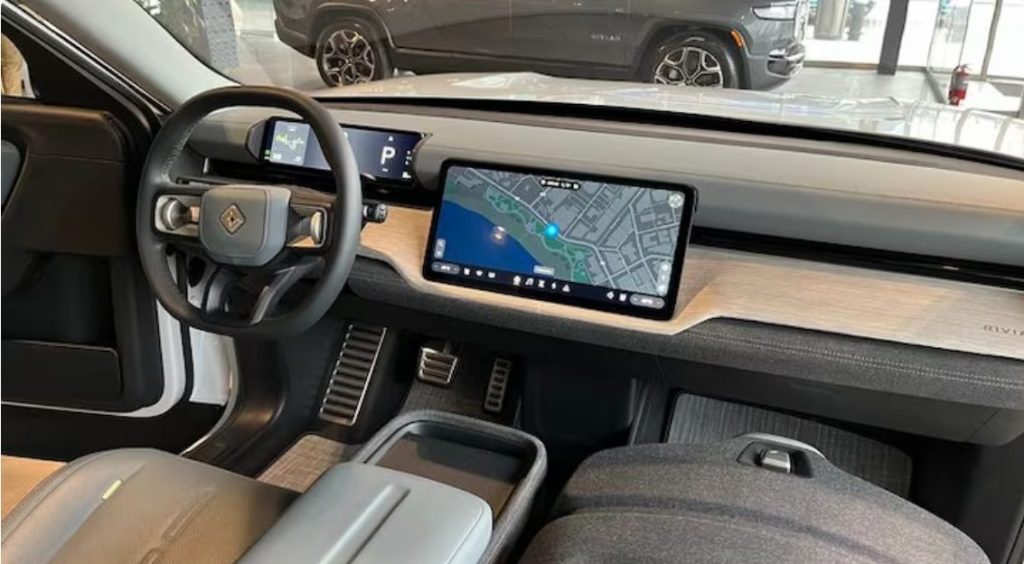
Screens Are Still Here
While it wasn’t surprising, the infotainment and driver information cluster screens persist in the R2 model. These screens allow users to choose drive modes, review vehicle settings, and perform tasks similar to those in the R1 models.
Yet, there’s a distinct improvement in the appearance of the screens in the R2—they boast sharper imagery, richer colors, and enhanced contrast. This enhancement is attributed to their utilization of the Unreal Engine, which significantly enhances their visual robustness. Take a closer look at the R2’s infotainment screen below:
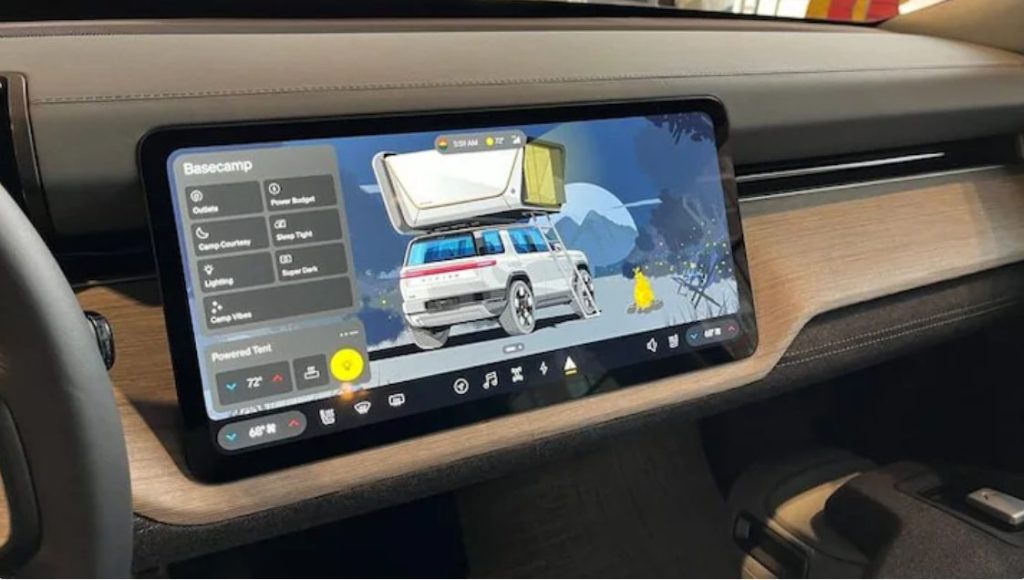
And here’s the display within the R1T in contrast:
Two Glove Boxes
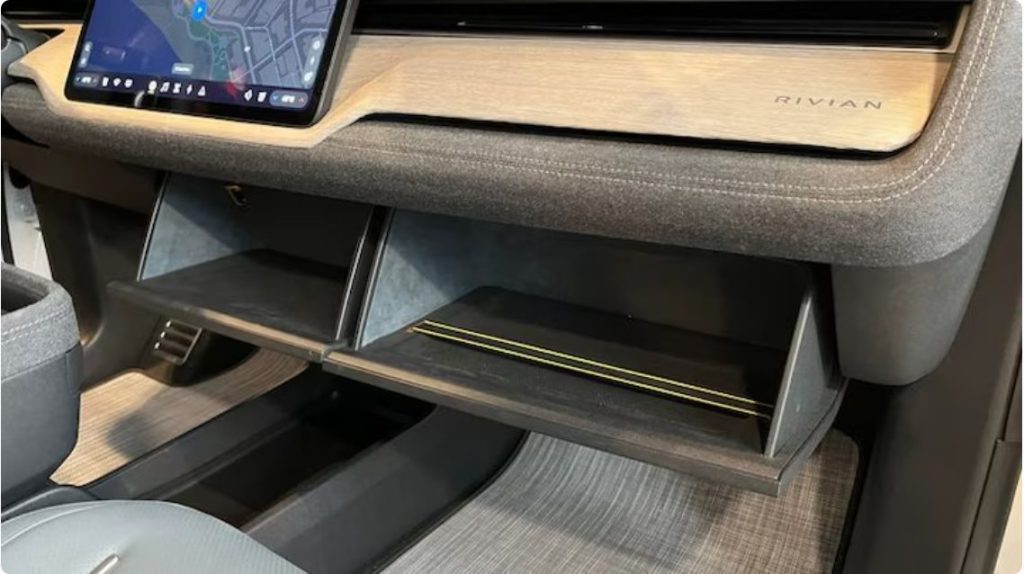
Some R1 owners found it frustrating that their vehicles lacked a traditional glove box, despite having numerous cubbies for storage. Rivian appears to be addressing this issue with the R2 model, which now boasts not one, but two glove boxes. These new compartments are easily accessible by pressing on a dashboard indentation, and they fold down conveniently. They offer ample space, and the passenger-side box even features an attached elastic band for added security.
Similar to the R1s, the R2 also features a front trunk alongside its rear cargo area, and both trunk floors can be raised to provide additional storage capacity. This space can accommodate charging cables, towels, tools, or any other items you may desire. The only challenge is remembering what you’ve stored inside since items can be concealed from sight.
Trunks With Additional Storage
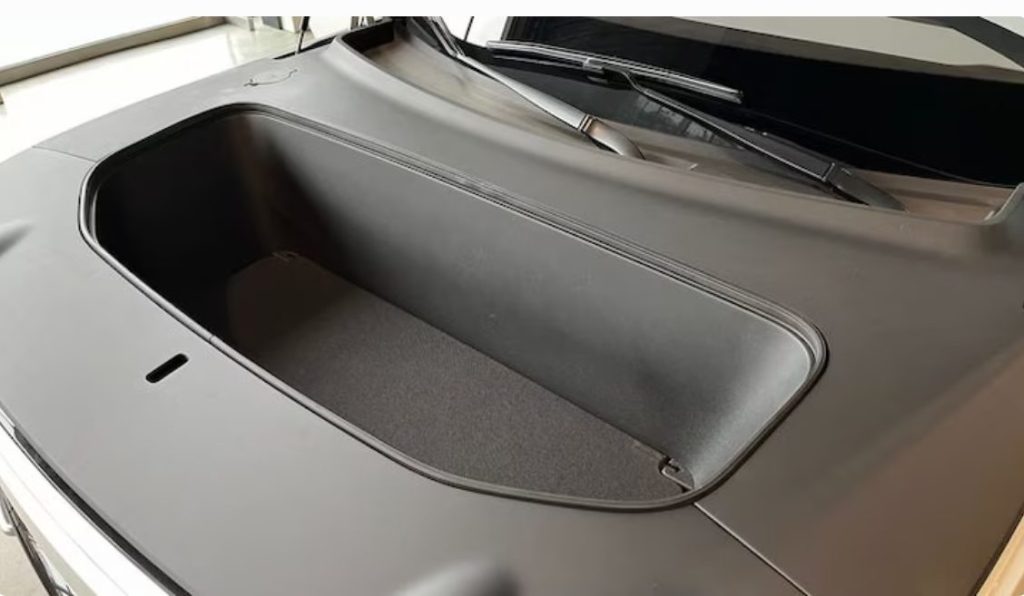
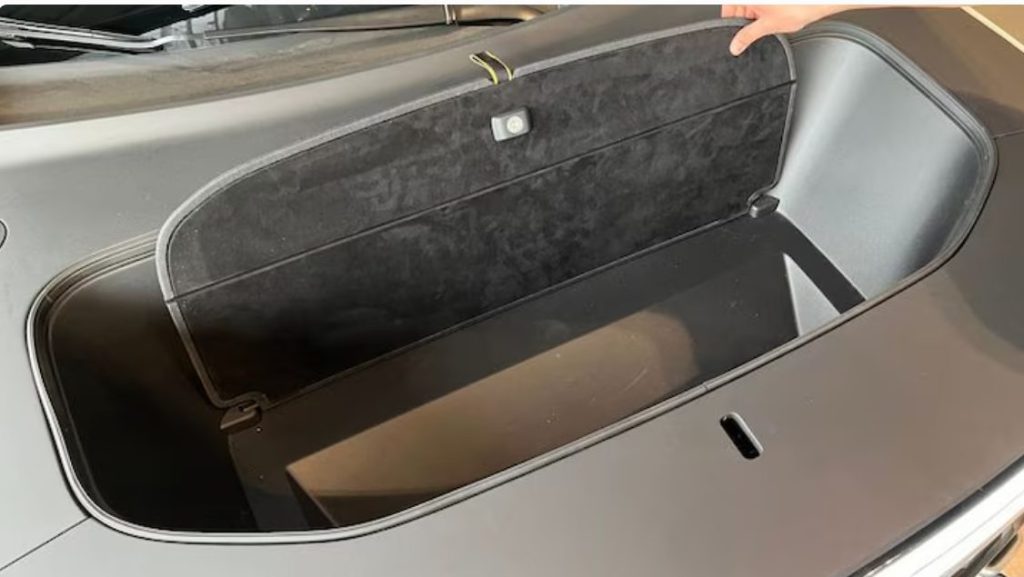
Haptic Steering Wheel Controls
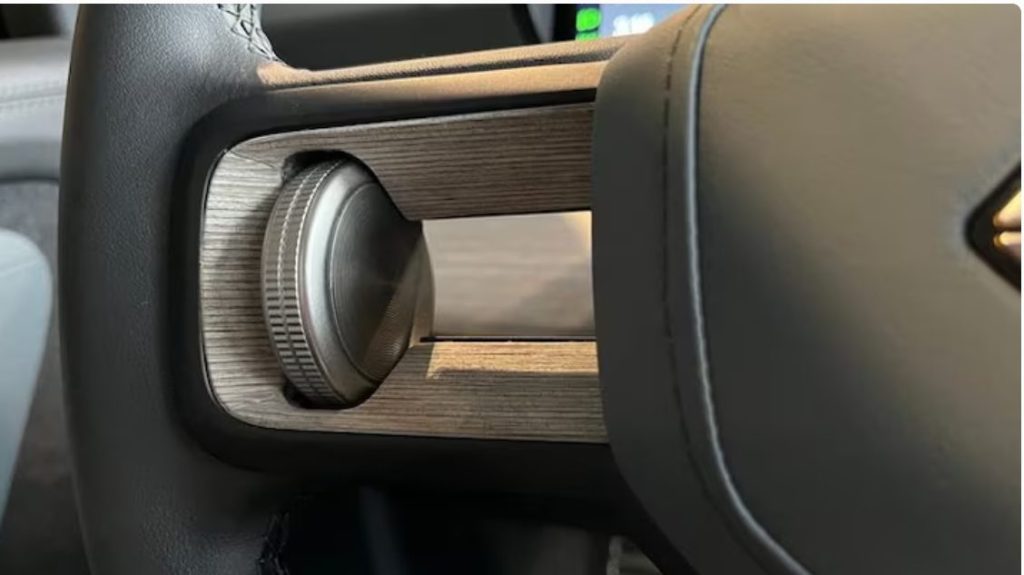
The tactile controls integrated into the steering wheel, which we previously examined in our initial assessment, indeed demonstrated user-friendliness. The tactile response was commendable and provided a gratifying experience. In the demonstration vehicle, the left-side wheel appeared to regulate functions such as radio volume and the compass, while the right-side wheel managed drive modes. By gently nudging and scrolling the wheel, users could navigate through various menu options.
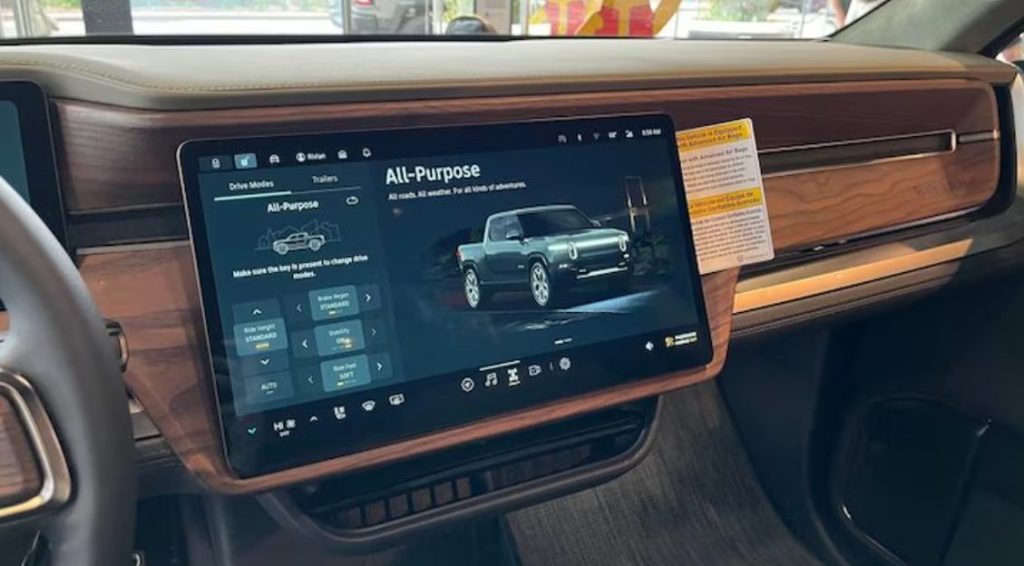
The operation resembled that of the Tesla Model 3 to some extent. While we have yet to test the R2 on the road, we anticipate that these controls will enhance driver focus on driving. Additionally, the visually striking roller switches, which seem to float, add to the aesthetic appeal.
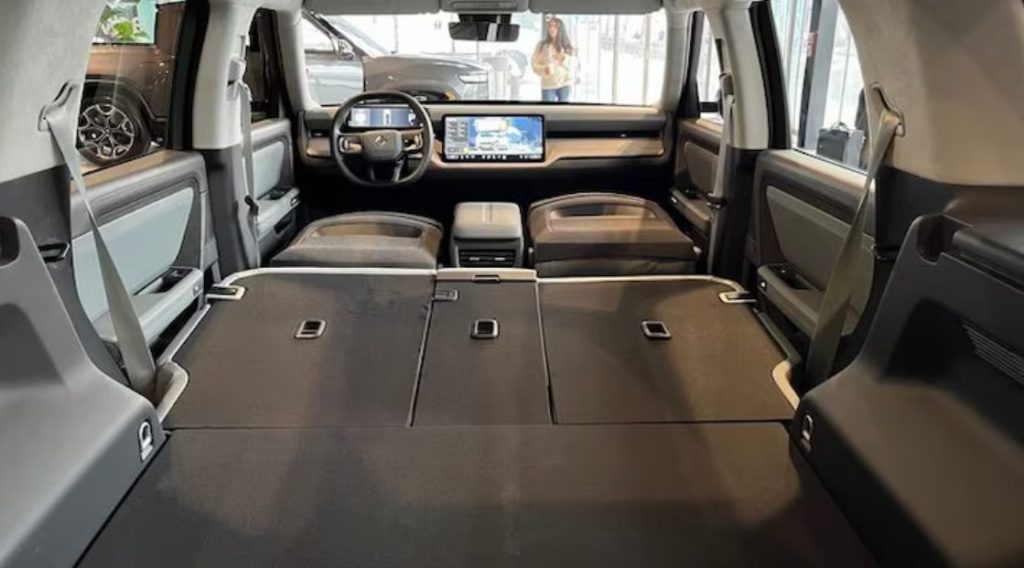
All The Seats Fold Down Flat
Attention all campers and haulers! Here’s a nifty feature: the R2 has the ability to fold down all five seats, creating a spacious flat surface. This offers ample room to lay down a mattress or place sleeping bags for a comfortable rest. Furthermore, thanks to its glass ceiling, stargazing while out in the wilderness becomes a viable option.
Moreover, this generous space proves useful for transporting bulky items as well. The expansive windows provide a sense of openness, particularly with no seats obstructing the view.
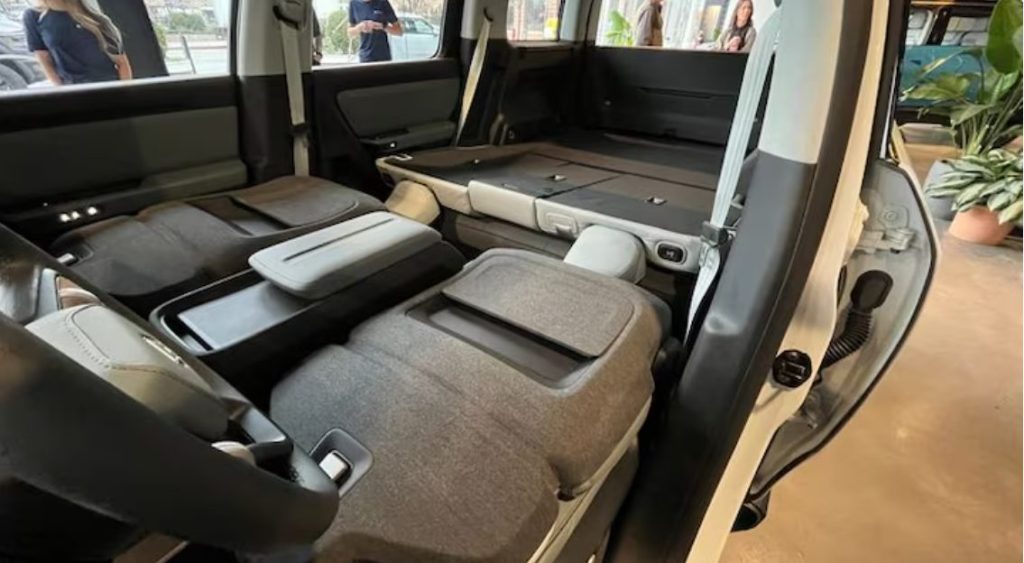
Device Charger Hidden In The Door
Nestled within the passenger door, in the spot typically reserved for flashlights in other Rivians, lies a charger for various devices. You can connect your batteries, phones, or any other gadgets to it. This feature proves especially handy if you find yourself in the wilderness and happen to forget your power brick.
Just A Spacious And Well-Thought-Out Interior
As anticipated, the R2 proved to be spacious and comfortable, boasting high-quality touchpoints and clever storage solutions, at least during this initial assessment. While the seats offer good support, taller individuals may find themselves wanting more hip support due to the rear bench’s proximity to the floor.
The level floor provides ample space to stretch out, and despite its large wheels, maneuvering around isn’t an issue. Overall, the R2 feels more manageable in size compared to the notably large R1s.
Being Rivian’s first globally targeted vehicle, the placement of its charge port near the rear passenger wheel arch is strategic, catering to the prevalence of streetside public chargers in other countries. With a starting price of $45,000, the R2 presents a compelling value proposition as the automaker’s anticipated volume seller. If Rivian can meet demand, it’s likely we’ll soon see these vehicles becoming commonplace in the next couple of years.
Automobile
Hyundai Santa Fe First Drive: Refreshed SUV Will Change Perceptions
The updated Santa Fe showcases a bold and appealing design, making a notable statement.
In an era where SUVs reign supreme, Hyundai has taken a daring move by redesigning the 2024 Santa Fe into a three-row SUV with a bold and rugged appearance. Setting itself apart from the competition with its elongated wheelbase, expansive windows, and Land Rover-inspired design, the revamped Santa Fe offers more than just a cosmetic transformation. The latest iteration boasts a standard third row, over 300 lb-ft of torque, and an upscale interior—all within a mere 2-inch increase in length compared to its predecessor.
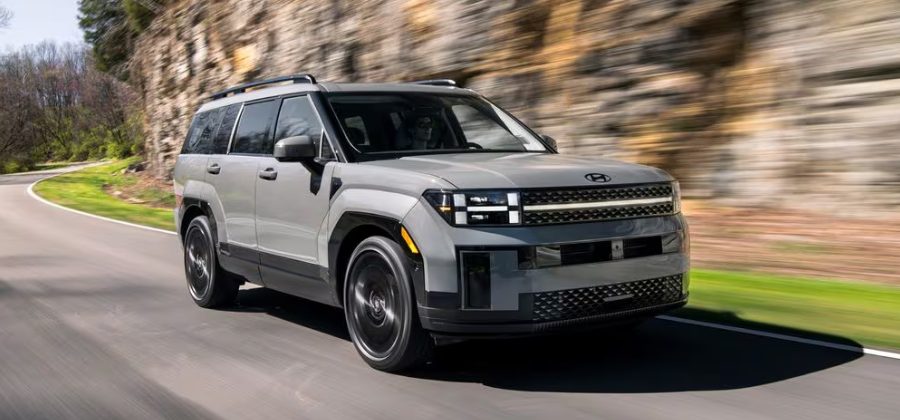
H Design Theme
Examining the 2024 Hyundai Santa Fe closely reveals a plethora of H’s—both prominent and subtle—besides the Hyundai emblem. This fresh design concept, evident both internally and externally, represents the meticulous attention to detail fostered by Kevin Kang, the head of Hyundai North American design, and his team, who collaborated remotely during the pandemic under the guidance of SangYup Lee, the chief of Hyundai and Genesis global design.
The enlarged H on the grille imparts a broader countenance to the 2024 Santa Fe, while the smaller H’s adorning the headlights and taillights contribute to a contemporary, rugged aesthetic. Internally, a broad H motif graces the dashboard, enhancing the perception of spaciousness within the cabin, while miniature H’s adorn the seat backs. Typically reserved for luxury or flagship vehicles, such intricate details are a rarity in an accessible midsize SUV.
Practical considerations also come into play. For instance, the cargo opening has a more squared shape, enabling greater capacity for storage. Additionally, both the second and third rows of seats can fold entirely flat, accommodating two adults of up to 6 feet in height for sleeping inside the vehicle.
Achieving this was no small feat, given the mere 2-inch increase in overall length compared to its predecessor, which posed engineering and design challenges. Furthermore, a C-pillar grab handle facilitates easier access to the roof, whether for loading luggage or setting up a rooftop tent.
Is This a Hyundai?
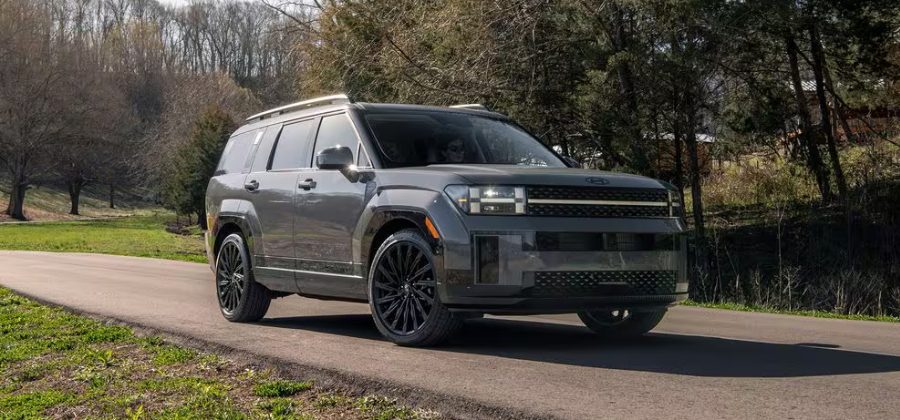
In addition to the tangible modifications, the 2024 Hyundai Santa Fe showcases numerous enhanced technological and safety attributes. A 12.3-inch screen is universally included, featuring wireless compatibility with both Apple CarPlay and Android Auto. Across XRT, Limited, and Calligraphy models, a standard fingerprint reader permits owners to access personalized profiles or establish speed restrictions for valet mode.
In terms of safety features, the 2024 Hyundai Santa Fe comes equipped with an array of functions, among them a novel driver-attention monitor utilizing an infrared camera positioned atop the steering column to ensure continuous focus on the road. While we appreciate the enhanced safety measures, we found the system somewhat overzealous during our test drive, issuing alerts even for fleeting glances towards the passenger seat.
During our test drive, we primarily experienced the capabilities of the fully equipped Santa Fe Calligraphy trim, which exclusively offers dual wireless chargers integrated into the center console. Additionally, the USB ports for rear passengers have been relocated to the front seat backs, facilitating convenient access to your phone while it charges, eliminating the need for lengthy cables.
Peppy Powertrain
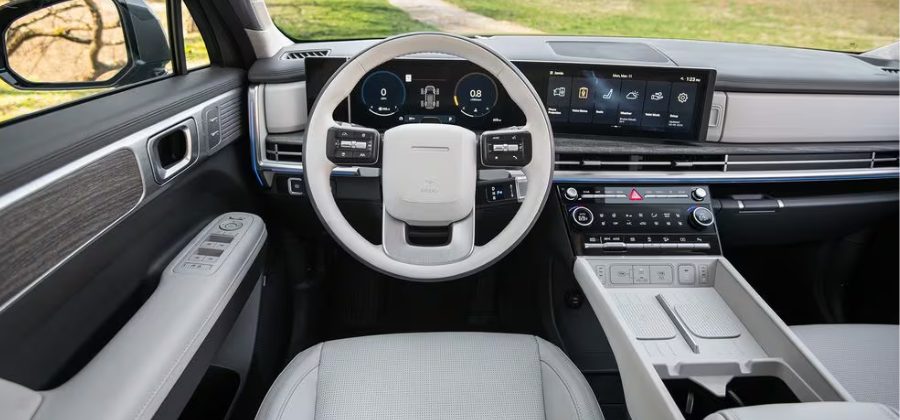
The meandering roads encircling Franklin, Tennessee, offered an excellent terrain for assessing the performance of the 2024 Hyundai Santa Fe, granting us a valuable opportunity to experience the engine’s characteristics and its responsiveness during overtaking maneuvers.
While a hybrid variant is slated for release in May 2024, our evaluation was conducted solely on the gas-powered Santa Fe equipped with a robust 2.5-liter turbocharged engine generating 277 horsepower and 311 lb-ft of torque. Power delivery is managed by an eight-speed dual-clutch transmission, distributing power to either the front or rear wheels depending on the selected drivetrain configuration. Front-wheel drive comes standard, with the option to upgrade to all-wheel drive for an additional $1,800 across all trim levels except the XRT, which includes AWD as standard.
Hyundai’s decision to standardize the turbo feature across all models is a welcome change, especially considering the previous Santa Fe’s lack of power. In comparison to other midsize SUVs like the Honda Passport and Toyota Highlander, the 2024 model now boasts competitive power figures.
Equipped with the 2.5-turbo engine, the 2024 Santa Fe delivers sufficient power, making passing on two-lane roads a breeze. Accelerating from a standstill feels lively, with smooth and swift transmission shifts. While we didn’t test it on highways, minimal road and wind noise infiltrated the cabin during our tranquil drive around Franklin.
Despite its bulkier frame and square design, the Santa Fe maintains a smooth ride on the road. Although there’s some noticeable body roll, it’s typical for vehicles in this class, and the suspension effectively absorbs vibrations, ensuring cabin comfort. While we hoped for more road feedback from the steering, it’s appropriately weighted for the segment, appealing to the majority of drivers.
Adventure Ready

We had the opportunity to test drive the 2024 Santa Fe XRT model, specifically designed for off-road adventures, on private trails in the Franklin area. Despite its minimal hardware variations from the standard Santa Fe—including specialized all-terrain tires and a subtle suspension lift providing an additional 1.3 inches of ground clearance—the capabilities of this variant were impressive.
Engaging its center differential lock, the Santa Fe XRT effortlessly ascended steep inclines, adeptly managing wheel traction and distributing torque effectively to navigate over obstacles. Furthermore, we utilized the hill-descent control feature, which enabled the Santa Fe to descend inclines at a controlled pace, with the driver simply adjusting speed using the pedals.
While the XRT may not be designed for intense rock crawling, it excels in accommodating families during camping trips and similar excursions. Although the trail we traversed was initially established by Hyundai for the Santa Fe launch event, the XRT navigated through obstacles effortlessly. These challenges exceeded typical overlanding experiences for most families.
Is the 2024 Hyundai Santa Fe Worth the Money?
Starting from $35,345, the 2024 Hyundai Santa Fe offers exceptional value, coming in nearly $8,000 cheaper than the starting price of the Honda Passport. Its sleek and robust design is a refreshing departure from the typical look of crossover SUVs, likely to appeal to buyers seeking something distinctive. Packed with advanced technology and meticulous attention to detail, the new Santa Fe presents an appealing option for families in search of a fresh choice.
The Santa Fe Calligraphy variant tops out at $50,195, a considerable sum yet still falling short of the highest-priced Toyota Highlander. In comparison to the Hyundai Palisade, a three-row model, the Santa Fe is somewhat more economical, though it sacrifices interior space and caters to a different demographic.
Now available at dealerships, the 2024 Hyundai Santa Fe will be joined by a hybrid model expected around May of this year.
| 2024 Hyundai Santa Fe Specifications | |
| BASE PRICE | $35,345-$50,195 |
| LAYOUT | Front-engine, FWD/AWD, 6-7-pass, 4-door SUV |
| ENGINE | 1.6L turbo DOHC 16-valve I-4 plus electric motor, 232 hp/271 lb-ft combined; 2.5L/277-hp/311-lb-ft turbo DOHC 16-valve I-4 |
| TRANSMISSION | 8-speed twin-clutch auto (2.5T); 6-speed auto (1.6T hybrid) |
| CURB WEIGHT | 4,300-4,600 lb (mfr) |
| WHEELBASE | 110.8 in |
| L x W x H | 190.2 x 74.8 x 67.7 in |
| 0-60 MPH | 7.0 sec (MT est) |
| EPA FUEL ECON | 19-36/26-35/22-36 mpg (est) |
| EPA RANGE (COMB) | N/A |
| ON SALE | Now |
Automobile
Tesla Cybertruck Interior Review: Hands-On With the Wild Pickup’s Cabin
Does the interior of the Cybertruck match the innovative exterior design characterized by its angular shape?
Tesla’s latest Cybertruck model for 2024 embodies a striking contrast. Whether navigating urban streets or stationed amidst foliage in a parking area, this all-electric pickup truck’s sharp edges and minimalist surfaces sharply contrast with its surroundings. This boldness demands attention, a fact evident in our comprehensive First Drive review. Interestingly, while the exterior of the 2024 Tesla Cybertruck may seem unconventional compared to conventional vehicles, its interior offers a sense of familiarity. Nevertheless, numerous distinctive features distinguish this new Cybertruck from any previous offerings by Tesla or other automotive manufacturers.
Front Row Ergonomics and Materials
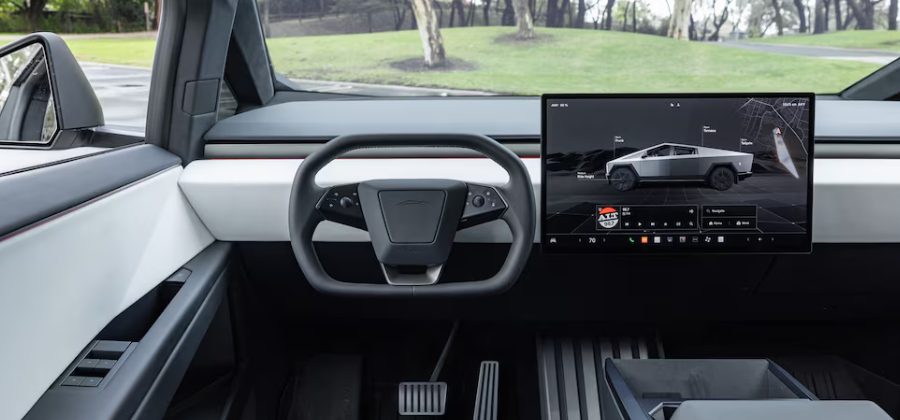
A rectangular button reminiscent of those seen in Star Trek is positioned just above the left side of each door, allowing access to the cabin of the sleek Tesla Cybertruck. Pressing this glossy tile prompts the door to slightly protrude, though it lacks the motorized opening feature found in the latest BMW 7 Series. Pulling on the unconventional “non-handle” beside the window and swinging open the stainless-steel door reveals it to be surprisingly lightweight. Upon entering the cabin, one notices a scuff plate adorned with the Cybertruck logo, adding a rugged texture to the interior. The front seats are generously cushioned, offering both heating and cooling ventilation for comfort.
Despite the Cybertruck’s exterior exuding a refrigerator-like chill, the cabin surprises with its spaciousness upon entering. The dashboard extends far ahead, and the expansive windshield provides a commanding view of the road. However, visibility to the rear is hindered by substantial blind spots, necessitating reliance on a rear-view camera displayed on-screen, given that the rear glass can be obscured by a motorized tonneau cover. Fortunately, Tesla’s camera systems offer high-resolution imagery with a refresh rate that avoids discomfort.
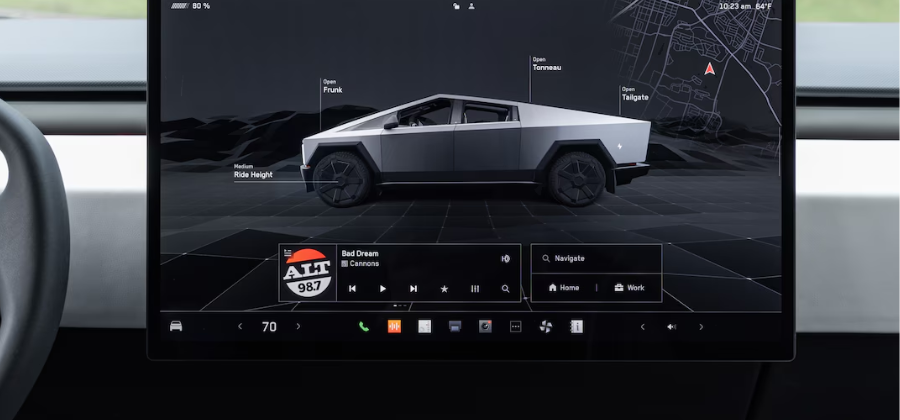
This all-wheel-drive Foundation Series Cybertruck comes fully loaded with special badging, white interior accents, and every available feature. While the additional trim adds flair compared to traditional Tesla interiors, the overall design remains understated. Materials are of high quality, offering a contrast to the exterior’s ruggedness. However, the white surfaces in the test vehicle showed signs of dirt despite its low mileage.
Notable features include octagonal cup holders, metal pedals, and rubberized pads in the cargo area, emphasizing the utilitarian aesthetic. For those familiar with Tesla’s other models like the Model 3 and Model Y, this Spartan interior won’t come as a shock.
Weighing in at approximately 6,600 pounds, the 2024 Tesla Cybertruck feels every bit as massive as its weight suggests, particularly at lower speeds. Equipped with Tesla’s distinctive squircle steering yoke, the ergonomics are satisfactory when hands are placed at the typical three and nine o’clock positions.
However, maneuvering can feel awkward during tight turns in parking lots if other parts of the rim are used. Similar to the 2024 Tesla Model 3, the Cybertruck features steering wheel buttons for various functions including turn signals, headlights, cameras, cruise control, wipers, and voice commands.
While operating without traditional turn-signal stalks is familiar for Tesla drivers, the method of shifting gears by swiping forward or backward may still be subject to debate. One delightful touch is the embossed Cybertruck silhouette at the center of the hub, adding a playful cyber element to the steering wheel’s design. Overall, the Cybertruck’s steering system leans more towards futuristic than traditional truck-like.
Cybertruck Tech
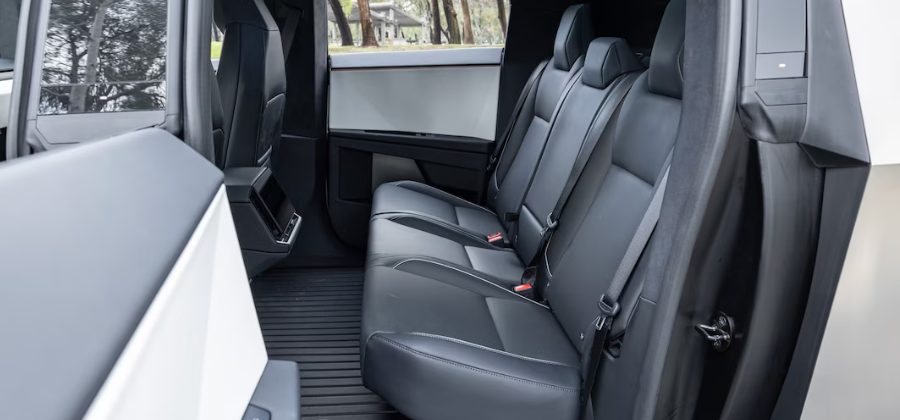
The centerpiece of the Cybertruck’s interior is its expansive 18.5-inch touchscreen, which serves as the hub for various functions such as displaying the speedometer, managing driver assistance systems, accessing infotainment options, and more. With its crystal-clear graphics and user-friendly menus, navigating the Cybertruck’s display is both seamless and visually striking, making it a standout feature to proudly showcase to friends. In addition to popular Tesla offerings like the Arcade, Theater, and Toybox features, users can also interact with a 3D model of the Cybertruck directly on the screen.
Tailored specifically for the Cybertruck, the interface includes specialized pages for selecting drive settings with customizable ride height adjustments, accessing Trailer Mode for towing assistance functionalities, and configuring exterior power outlets for accessories. Enhanced with unique Cybertruck graphics and fonts, the user interface ensures a distinct and memorable experience that sets it apart from other Tesla models.
What’s It Like to Ride in the Cybertruck’s Back Seat?
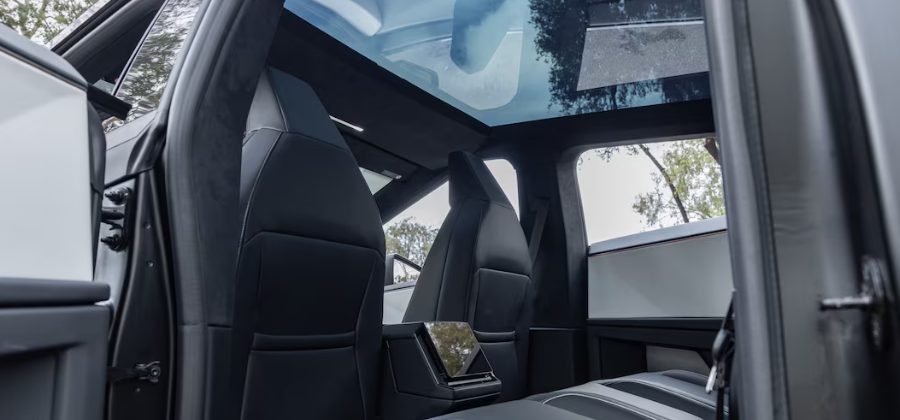
Perched in the second row of the Cybertruck, one is treated to a breathtaking view of the expansive sky through the dramatic panoramic glass roof. While the side windows are relatively small, the tinted ceiling effectively enhances the sense of openness within the cabin. Although the seatbacks maintain a fairly upright position, they provide adequate bolstering, ensuring passengers remain securely seated even during spirited cornering maneuvers. While legroom may not match that of a traditional full-size truck, accommodating two average-sized adults in tandem shouldn’t pose any discomfort. Notably, the suspension delivers commendable comfort from the rear seats, prompting speculation about the imminent prospect of hailing a Cybertruck for an Uber or Lyft ride.
A central armrest equipped with two additional octagonal cup holders and seatback pockets enhances convenience and storage options. Angular shelves on the doors feature rimmed edges, effectively securing small items like cellphones and water bottles. Despite a lack of visual stimulation beyond the screens and vents, there’s a discernible improvement in materials and build quality compared to previous Tesla models. Adding to its practicality, the Cybertruck’s seat bottoms can be flipped up to reveal a flat floor, ideal for transporting groceries or small packages.
The Verdict
While the 2024 Tesla Cybertruck pushes the boundaries of brutalist automotive design with its exterior, the interior largely adheres to the familiar Tesla aesthetic. This isn’t necessarily a drawback; despite its radical appearance, the Cybertruck remains practical for everyday use. Our primary critique revolves around the pricing of the Foundation Series model, which, according to the owner who loaned it to us, costs around $99,000.
Enhancing the interior with additional Easter Eggs or distinctive features could greatly enhance the sense of uniqueness within this electric pickup truck. While we hesitate to describe Tesla’s angular creation as cozy, the Cybertruck’s cabin likely meets the expectations of the automaker’s enthusiasts. Looking ahead, Tesla would benefit from infusing the same futuristic imagination displayed in the vehicle’s exterior into its interior design.
Automobile
Light ’em Up: A Guide to Common Dashboard Warning Lights
Understanding the significance of these symbols can directly influence both your safety and that of your vehicle.
Like many objects, cars are not flawless. It’s reasonable to anticipate that something will eventually malfunction or cease functioning regardless of the type of car you purchase, and irrespective of how dependable it’s reputed to be. Fortunately, the figurative “brain” of your car will usually detect an impending issue before you do and issue a warning. Modern cars are equipped with sensors and warning indicators that notify you about tire pressure levels and the level of washer fluid. However, are you familiar with the significance of all those small symbols on the dashboard? If not, don’t worry, we’ve got you covered. We’ve compiled this guide to explain the meanings of 10 of the most commonly encountered car warning lights.
Fog Lights

Like many objects, cars are not flawless. It’s reasonable to anticipate that something will eventually malfunction or cease functioning regardless of the type of car you purchase, and irrespective of how dependable it’s reputed to be. Fortunately, the figurative “brain” of your car will usually detect an impending issue before you do and issue a warning. Modern cars are equipped with sensors and warning indicators that notify you about tire pressure levels and the level of washer fluid. However, are you familiar with the significance of all those small symbols on the dashboard? If not, don’t worry, we’ve got you covered. We’ve compiled this guide to explain the meanings of 10 of the most commonly encountered car warning lights.
Low Tire Pressure

Contemporary vehicles are equipped with tire pressure monitoring systems, denoted by a small exclamation point enclosed within a half-circle. This indicator simply alerts you to the possibility of low tire pressure. If this symbol appears, there’s no need to panic. Instead, safely pull over and examine your tires. Should they appear deflated, proceed cautiously to the nearest gas station to inflate them. Typically, after topping up the tire pressure, this warning light will automatically extinguish.
Engine Oil Warning Light
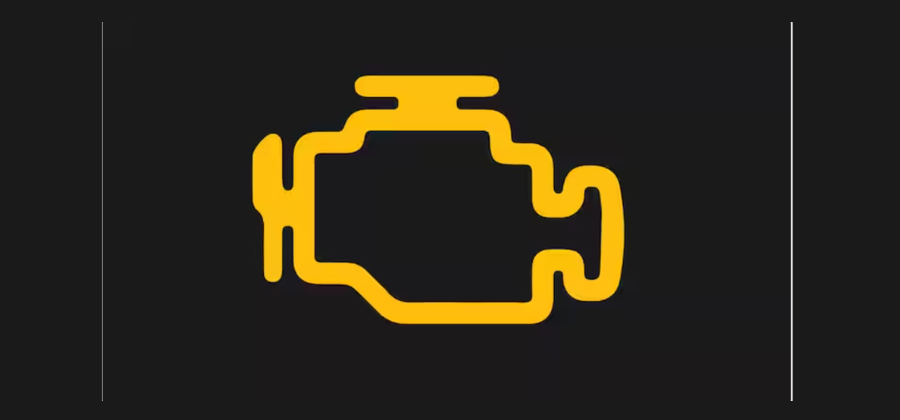
Cars have had the capability to monitor their engine’s oil pressure for quite some time. If you’ve noticed a warning light resembling a gravy boat appear on your dashboard, it indicates an issue with your engine’s oil pressure. Inadequate oil pressure can hinder proper lubrication of the engine, potentially resulting in significant mechanical issues such as engine seizure, which could leave you stuck. Therefore, it’s advisable to address this concern promptly by seeking professional assistance.
Check Engine Light

The illuminated check engine light indicates that one of the numerous sensors responsible for monitoring your vehicle has detected an issue with the engine. This could range from a malfunctioning spark plug to a more significant problem like a faulty intake manifold or reduced compression. Unless you possess advanced mechanical skills, it’s advisable to entrust the resolution of such issues to a reliable mechanic. Regardless, if you notice the check engine light illuminated on your dashboard, it signifies a problem that necessitates prompt attention, and delaying a visit to the repair shop is not recommended. Addressing the issue as soon as possible is paramount for optimal vehicle performance and safety.
Traction or Stability Control Light
Many vehicles equipped with traction or stability control systems offer the option to deactivate these functions. If you observe what resembles the rear view of a classic sedan with wavy lines trailing behind it, it indicates that your stability control system is either partially or completely disengaged. This situation typically arises due to one of two scenarios: either you deliberately disabled the function to engage in spirited driving (remember, you’re not Lewis Hamilton, so it’s advisable to re-enable it) or the feature has malfunctioned. It’s prudent to allow the computer to manage traction for you, hence it’s essential to promptly reactivate it.

Coolant Level Warning Light
If you notice a small thermometer icon appearing on your dashboard, it likely indicates that your car is experiencing overheating. While there could be various reasons for this issue, the advisable course of action is to immediately stop the car and allow the engine to cool down naturally for a significant period. Subsequently, retrieve a cloth, open the hood, and carefully use the cloth to lift the cap of the coolant reservoir, checking the coolant level. In case the engine, coolant reservoir, or coolant tank is emitting smoke due to excessive heat, it may be prudent to contact a towing service for assistance.

Brake System Warning Light
If you notice an exclamation mark encircled on your dashboard, it signals an issue with your brakes. This could indicate a fault in brake components or a requirement for topping up the hydraulic fluid. It’s crucial to halt the vehicle and promptly contact a towing service. Continuing to drive with compromised brakes is perilous and warrants immediate attention to ensure safety on the road.
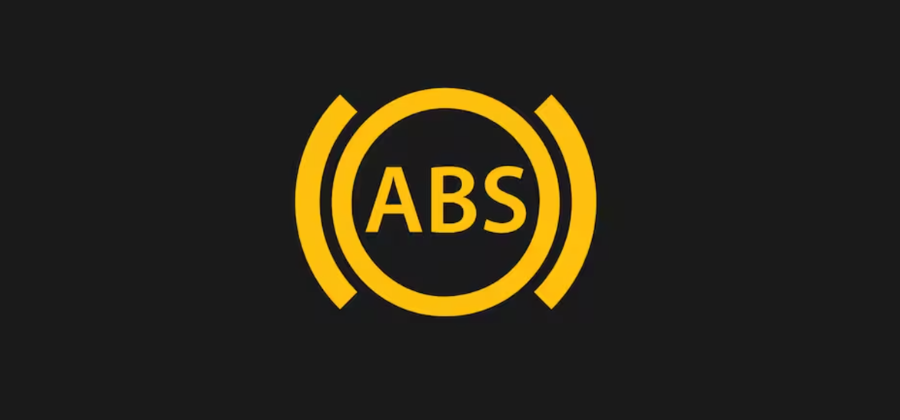
ABS Sensor Warning Light
Even though it pertains to the braking mechanism, the ABS warning light doesn’t indicate a malfunction in the actual brakes themselves. Rather, it indicates a problem with the anti-lock brake system. If you apply sudden and excessive pressure on the brakes with this light illuminated, there’s a possibility that your vehicle’s brakes might seize, making it challenging to bring the car to a complete halt. It’s advisable to seek assistance from a professional at a repair shop in such instances, considering that ABS ranks among the most significant safety advancements in automobiles since the introduction of seatbelts.

Airbag Warning Light
Nowadays, all vehicles come equipped with airbags, a federal requirement that ensures safety standards are upheld, as they rightfully should be. Occasionally, drivers may notice an airbag warning light illuminated on their dashboard. This indicator can signify various issues, such as malfunctioning crash sensors responsible for deploying airbags during collisions. If this warning light persists, it’s advisable to promptly have your vehicle inspected at a reputable auto shop.

Battery Light
If you notice a small red battery icon illuminated on your dashboard, it indicates that your vehicle is currently running solely on battery power. In the absence of the engine being operational, the alternator ceases to charge the battery, leading to eventual depletion and the potential need for a jumpstart to restart your car. Should this indicator persist while your engine is running, it generally suggests a malfunction in the battery charging system. In such instances, seeking professional assistance to diagnose and address the issue is imperative.
Unlock Gear Selector Light

The green shoe icon is a familiar symbol associated with brake functions, featuring a circular design with small arcs resembling traditional brake drum and shoes, positioned at three and nine o’clock. This symbol specifically appears in vehicles equipped with automatic transmissions. Its purpose is to signal the driver to engage the brakes in order to release the gear selector from the park position. Upon applying pressure to the brake pedal, the symbol should deactivate.
Low Fuel Light
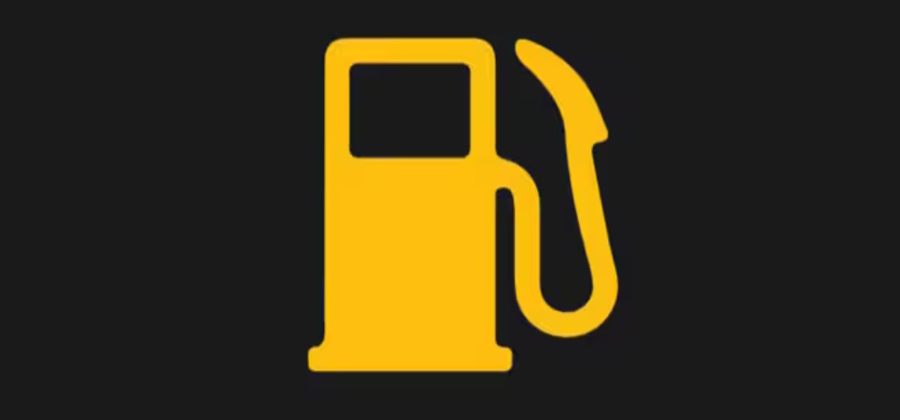
When this indicator lights up, it signals the need to refuel your vehicle due to low fuel levels. In certain vehicles, the activation of this indicator is based on a predetermined amount of fuel remaining in the tank, while in others, the car’s computer analyzes both fuel levels and recent driving patterns to anticipate a potential fuel shortage. Occasionally, instead of an icon, a straightforward light may serve this function.
Diesel Glow Plugs Active

This particular symbol pertains to vehicles running on diesel fuel and signifies the activation of glow plugs. These plugs serve the purpose of heating the air inside the cylinder before ignition, counteracting the potential failure to start caused by the metal components absorbing the heat from the compression of fuel and air. (Unlike gasoline vehicles, diesel engines lack spark plugs and depend on compression-generated heat to initiate combustion.) When this indicator ceases to illuminate, you can commence starting your vehicle. However, if it blinks, it could indicate a malfunction within the glow-plug system.
Automobile
What in the Duck Is Jeep Ducking?
The trend captivating the global Jeep community originated from a single individual’s gesture of goodwill.
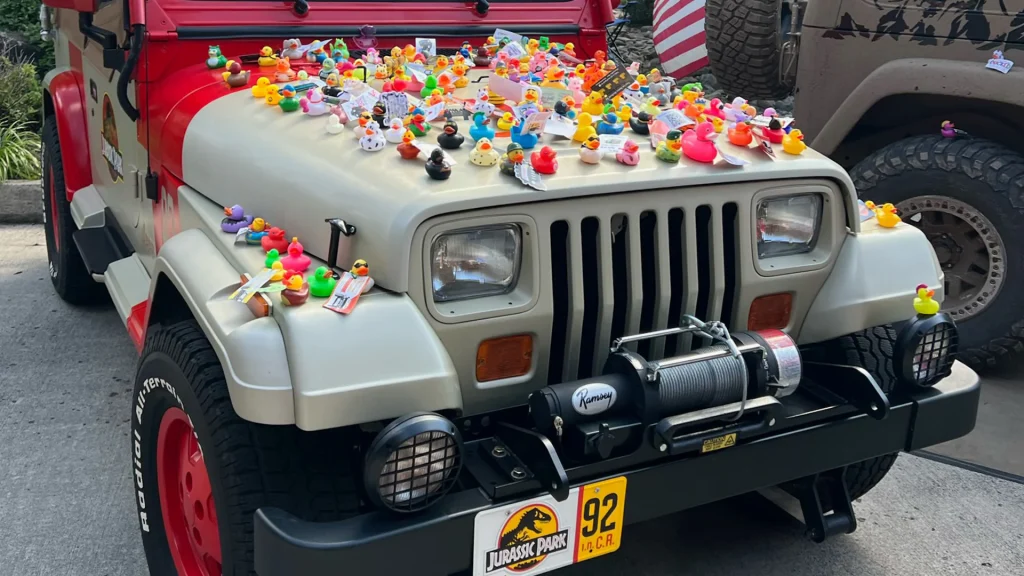
The practice of placing a rubber duck on a Jeep, commonly known as Jeep “ducking” or “Duck Duck Jeep,” originated with Allison Parliament, a resident of a small town in Ontario, Canada. Unintentionally, she sparked a movement centered around kindness, camaraderie, and acknowledgment through her initial placement of a rubber duck on a Jeep.
Allison’s decision to perch a small yellow duck on a Jeep Wrangler similar to her own, which she spotted in a parking lot, stemmed from her desire to find solace after a distressing verbal and physical altercation earlier that day. Fast forward two years, and this simple act has evolved into the phenomenon of Jeep ducking, spreading across the United States and reaching nearly a dozen other countries.
Curious about the guidelines of Duck Duck Jeep or Jeep ducking? Wondering who can participate or if it’s exclusive to Jeeps? Keep reading to discover how you can become involved in this Jeep ducking craze. (Editor’s Note: Special thanks to “Official Ducking Jeep Est2020” for providing the images featured in this narrative.)
What Is Jeep Ducking and Why Do Jeeps Get Ducked?

Allison Parliament, acknowledged as the instigator of the Jeep ducking trend, explains that “Ducking Jeeps occurs for various reasons, each imbued with different motivations and significance. Personally, it served as a gesture of kindness, a form of personal healing, and a way to acknowledge and greet fellow Jeep enthusiasts. However, it could simply stem from admiration for their vehicle, a shared ownership of the same model, or a fondness for a classic Jeep one aspires to possess. Engaging in Jeep ducking doesn’t necessarily require a specific rationale beyond fostering connections, eliciting smiles, and enjoying the experience.”
Is Duck Duck Jeep Just for Jeep Wranglers?
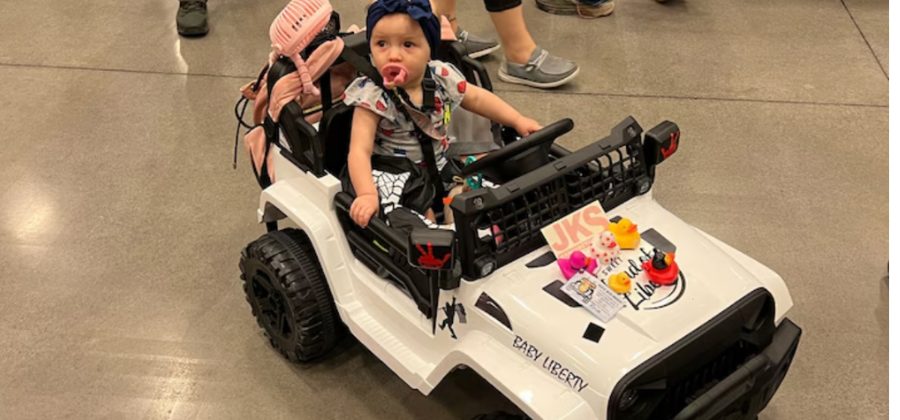
The tradition of Jeep ducking originated with the Jeep Wrangler community, but it has evolved to encompass any Jeep model. Jeep ducking is a gesture of admiration towards fellow Jeep enthusiasts and their vehicles. This spontaneous display of kindness is inclusive of all Jeep types, regardless of their age, condition, or level of modification, whether they are pristine or weathered, stock or customized for off-road adventures. Duck Duck Jeep is a game that transcends Jeep models, extending even to children’s toy Jeep wagons.
What Are the Rules for Jeep Ducking?
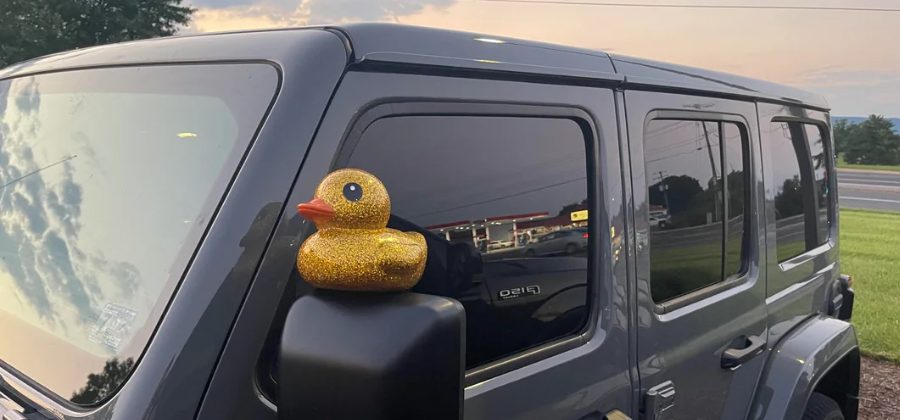
Allison explained that there aren’t rigid guidelines on how to “duck” someone’s Jeep, but the concept revolves around maintaining politeness and avoiding intrusion. She emphasized her policy of refraining from placing a rubber duck inside anyone’s Jeep. “Moreover,” she continued, “I ensure that the rubber duck is positioned where the driver will promptly notice it upon approaching their vehicle.” She suggested suitable locations on a Jeep to place the duck include atop the side mirrors or door handles, the front bumper, the engine hood’s front, or the front fenders.
Can You Duck Non-Jeep Vehicles?

Given the flexible guidelines of Jeep ducking and its underlying spirit of kindness, it feels appropriate to extend this gesture beyond just Jeeps, embracing other vehicles that align with the mood and the setting. Stories abound of Jeep owners affixing rubber ducks onto vehicles resembling the Jeep Wrangler, like Ford Broncos, Suzuki Samurais, and vintage Land Cruisers. Some car owners have even personalized their vehicles with duck-themed adornments.
Are Yellow Rubber Ducks Best for Ducking Jeeps?
The classic small, yellow rubber duck (some now adorned with slotted grille designs) serves as a top pick for Jeep aficionados partaking in Jeep ducking. These rubber ducks are readily accessible (ideal for maintaining anonymity) and affordably priced. Renowned for their vibrant yellow hue, they effortlessly contrast with the paint of any Jeep, while also providing a convenient surface for leaving messages.
What To Write on the Rubber Duck

Leaving a rubber duck on someone’s Jeep is a common gesture, yet many prefer to customize the duck with a personal message beforehand. Frequently, this message is as straightforward as “Admiring your Jeep.” Alongside this sentiment, the yellow rubber duck bears the Instagram hashtag #duckduckjeep, aiming to spread positivity within the community of Jeep enthusiasts.
Fancy Rubber Ducks, Tags, and Where To Get Them
The classic yellow rubber duck can be easily found from various sources like Amazon.com. However, for those seeking to add a touch of flair to their Jeep ducking experiences, there’s a plethora of upscale and fashionable ducks on offer. Take, for instance, the stunning rhinestone-studded duck showcased here, complete with a personalized tag. Pairing a fancy duck with a custom tag can craft a unique duck perfectly suited for your Jeep-ducking adventures.
Ready for Ducking Jeeps With Rubber Ducks
While many Jeep enthusiasts might carry just a couple of ducks and a marker in their glove box, Allison Parliament is equipped to handle numerous Jeeps with her extensive collection. Transporting a variety of rubber ducks in different shapes, sizes, designs, and colors is standard practice for Allison as she journeys to advocate for the Jeep lifestyle.
What Is a Jeep Duck Pond?
Certainly! Here’s a rephrased version:
Several Jeep enthusiasts have been gifted or accumulated numerous rubber ducks over time, resulting in a diverse array of colors, shapes, and sizes adorning their Jeep’s dashboard. This assortment, affectionately referred to as the “duck pond” within their vehicle, often extends from one end of the dashboard to the other, sometimes even spilling over onto the windows.
Allison Parliament, BFGoodrich Ambassador for Jeep Ducking
Allison Parliament serves as a member of the BFGoodrich Ambassador program, extensively journeying to numerous prominent Jeep gatherings nationwide. Her primary goal is to ignite the passion for Duck Duck Jeep and Jeep ducking within the community of Jeep enthusiasts. Accompanied by her customized silver Jeep Wrangler JKU, Allison actively participates in BFGoodrich’s OnTrail exhibit section at renowned events like the Easter Jeep Safari held in Moab, Utah. Visitors to the OnTrail exhibit can also discover exclusive BFGoodrich-themed Jeep ducks.
Automobile
Toyota Tacoma TRD Pro First Drive: One Hell of a Truck for … How Much?
The Tacoma TRD Pro is an impressive off-road truck straight from the factory, but its high price might make it a challenging sell.
The Tacoma TRD Pro is a remarkable off-road truck right out of the factory, though its steep price tag could make it a tough sell.
“Oh, yeah,” he replied, showing me the back of his camera.
The photos proved he was telling the truth. At first glance, it might seem like a silly question, but the 2025 Toyota Tacoma TRD Pro jumps so well that I genuinely couldn’t tell from the driver’s seat.
Challenge Accepted
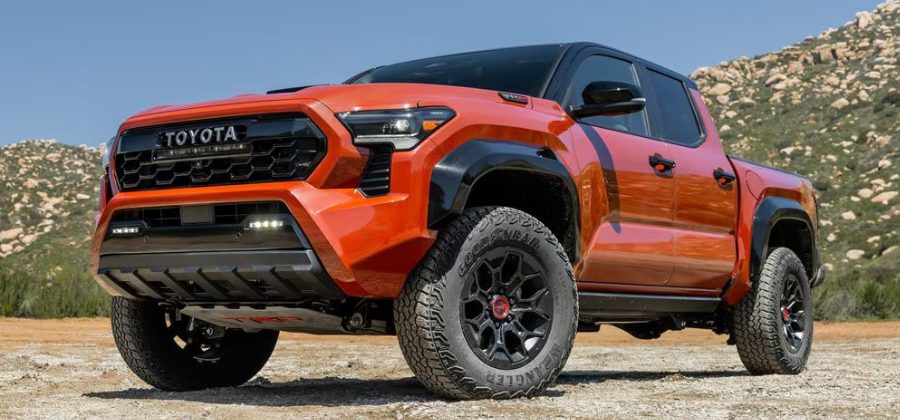
The 2025 Toyota Tacoma TRD Pro has always been designed for high-speed desert adventures, but never with this level of seriousness. Increasing competition from Chevrolet, GMC, and Ford has captured Toyota’s attention, prompting the development of a superior TRD Pro model. As consumers, we benefit from this fierce competition.
The foundation is the new TNGA-F truck platform, which all new Tacomas will utilize. The standard iForce Max powertrain combines a 2.4-liter turbocharged four-cylinder engine with a 48-hp electric motor placed between it and the new eight-speed automatic transmission. This setup includes a two-speed transfer case and an electronically locking rear differential, delivering a total of 326 hp and 465 lb-ft of torque, significantly outperforming the old V-6. Other off-road-focused Tacomas also feature a manual electronically disconnecting front anti-roll bar and 33-inch Goodyear Wrangler Rugged Terrain tires. Notably, the black hood scoop on this model is partly functional, allowing air into the engine bay, though it does not feed the TRD-specific intake or the intercooler.
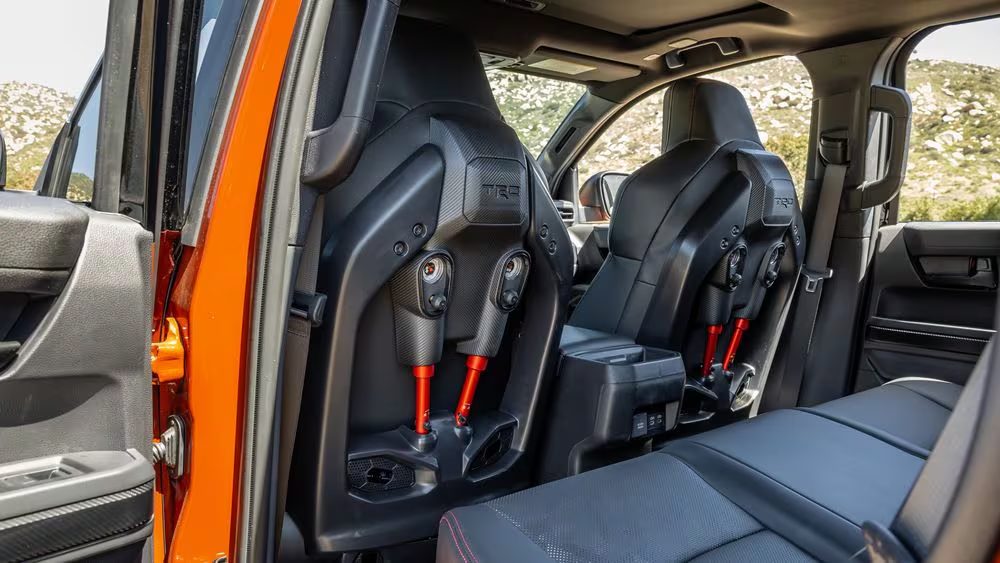
The key upgrades are at the corners of the vehicle. Each corner is equipped with 2.5-inch Fox Racing QS3 internal bypass shocks, with the rear ones featuring remote reservoirs for manual compression adjustment. Additionally, Fox Internal Floating Piston hydraulic bump stops are installed at the rear to cushion impacts when the suspension bottoms out, such as during landings. The springs and anti-roll bars are optimized for high-speed handling, with the front suspension’s upper control arms made from forged, anodized red units engraved with TRD Pro logos. This setup provides the truck with a 2-inch lift in the front and a 1.5-inch lift in the rear, resulting in 11.5 inches of ground clearance.
An additional highlight of the truck is Toyota’s innovative IsoDynamic Performance Seat, a bucket seat with integrated shock absorbers. Available exclusively on the 2025 Tacoma TRD Pro for the front seats, these seats are designed to absorb both lateral and vertical impacts, enhancing occupant comfort and allowing the driver to maintain better focus on the trail, even over the roughest terrain.
Let’s Do This
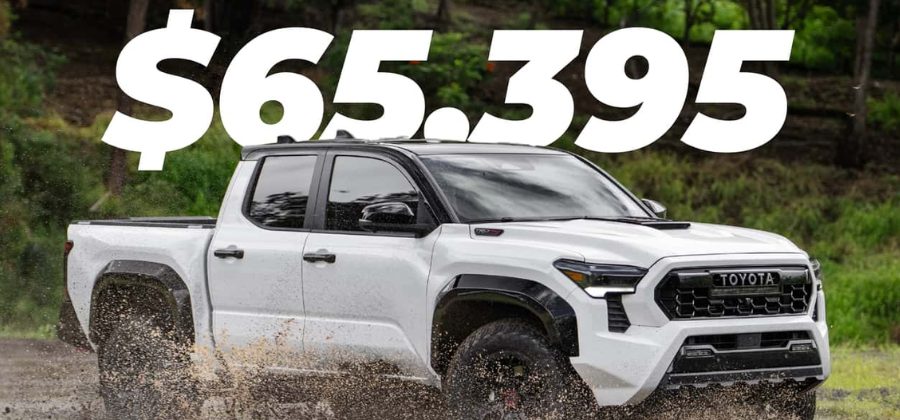
Somewhat unsurprisingly, the first thing you notice is the seats. Twist your torso left or right, and the side bolsters flex and give instead of holding you tight. This might seem counterintuitive for those used to racing seats, which are usually quite rigid. However, it makes sense when you consider that racetracks are typically smooth, where you’re pushed and pulled by g-forces rather than thrown around. Off-road, you experience both g-forces and big impacts.
When speeding down a dirt road, the combination of give and support during lateral motions stands out the most; your head doesn’t get thrown side to side nearly as much as you would expect. The cushioning provided for vertical impacts is harder to detect and would require a back-to-back comparison with a standard seat to fully understand, but we’re inclined to trust Toyota on this.
More noticeable is how much softer the suspension is compared to the Trailhunter or TRD Off-Road models. It’s not as soft as the first-generation Ford F-150 Raptor and likely doesn’t have as much travel, but it’s more than sufficient to let you achieve some real speed on dirt without worrying about damage. When taking it off a jump, there was no loud bang when the suspension reached its limit, and thanks to the compression damping, there was no harsh landing. We hit the jump several times for testing and only felt the landing when we were fast enough for the front wheels to land noticeably before the rears, and even then, it wasn’t bad.
The suspension is complemented by the surprisingly sharp steering, even on dirt. The Trailhunter has the same tires but doesn’t handle like this. The new Tacoma TRD Pro’s front end is much sharper, diving into corners with sports-car-like tenacity. Without using any of the numerous off-road modes, the truck is ready to tear across the desert or through the woods straight from the factory.
This performance translates to the road as well. The way the Tacoma TRD Pro drives into a corner and grips the road makes you want to drive it like a sporty SUV. The body movements are so well controlled that you’re immediately comfortable pushing it. Anytime you can keep up with the motorcycles you just waved by on a twisty road, it’s a good time, and it’s even more rewarding in a truck.
Priced Like a Sports Car
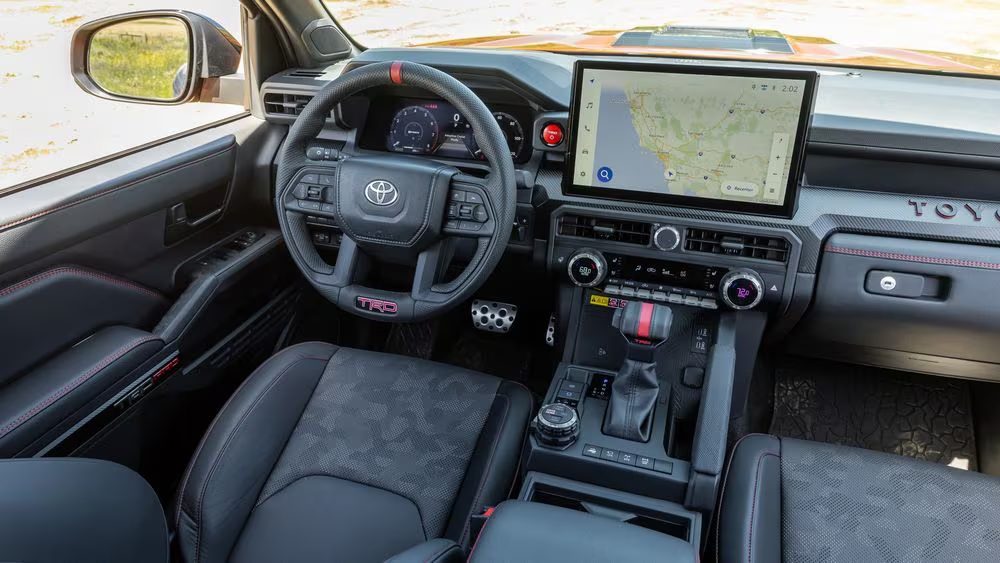
Oh, you thought the Ford Ranger Raptor was pricey at a starting price of $57,065? Think again. Toyota is asking $65,395 for the 2024 Tacoma TRD Pro, which only comes with one configuration: a four-door cab and a short bed, a common setup for off-road trucks. That’s an $8,000 premium for a vehicle with 79 less horsepower. Moreover, you can get a Chevrolet Colorado ZR2 for $48,395, which is $17,000 cheaper and offers similar specifications on paper. A thorough comparison test is needed to determine if this price reflects Toyota’s confidence in the Tacoma TRD Pro’s performance, but one thing is clear: you’re getting an impressive truck for that amount of money.
| 2024 Toyota Tacoma TRD Pro Specifications | |
| BASE PRICE | $65,395 |
| LAYOUT | Front-engine, 4WD, 5-pass, 4-door truck |
| ENGINE | 2.4L/326-hp/465-lb-ft turbo DOHC 16-valve I-4, plus 48-hp/NA-lb-ft electric motor; 323 hp/465 lb-ft comb |
| TRANSMISSION | 8-speed auto |
| CURB WEIGHT | 5,000 lb (mfr) |
| WHEELBASE | 131.9 in |
| L x W x H | 213.0 x 77.9 x 74.5 in |
| 0-60 MPH | 6.0 sec (MT est) |
| EPA FUEL ECON | 22/24/23 mpg |
| EPA RANGE, COMB | 419 miles |
| ON SALE | Now |
-
Whatsapp12 months ago
YoWhatsApp Apk v9.74 Latest Version Download for Android (Yousef) 2023
-
Tech2 months ago
How to Remove AI From Your Google Search Results
-
Whatsapp12 months ago
Download GBWhatsApp Pro APK v17.51 Latest Version (Official) AUGUST 2023 [Anti-Ban]
-
Blog2 months ago
Immune Boosters: Harnessing the Power of Peels for Vitality
-
Tech2 months ago
How to Use Google’s Circle to Search AI Feature to Quickly Look Up Text, Images
-
Whatsapp12 months ago
WhatsApp Plus APK Download Latest (Updated) v17.40 Official Anti-Ban 2023
-
Blog2 months ago
wellhealthorganic.com/how-to-build-muscle-know-tips-to-increase-muscles
-
Whatsapp12 months ago
Fouad WhatsApp APK Download Latest Version 2023 v9.74







